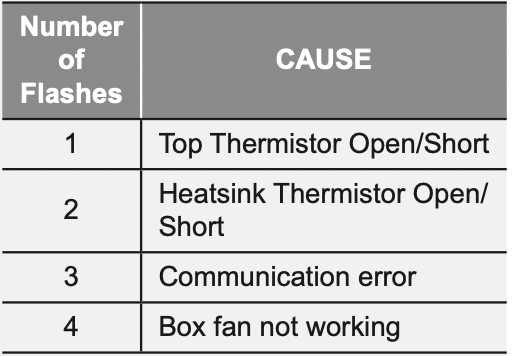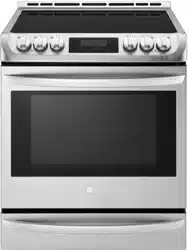Documents: Go to download!
- Owner's manual - (English)
- PRODUCT OVERVIEW
- OPERATION
- MAINTENANCE
- TROUBLESHOOTING
Table of contents
Owner's Guide Range
PRODUCT OVERVIEW
Parts
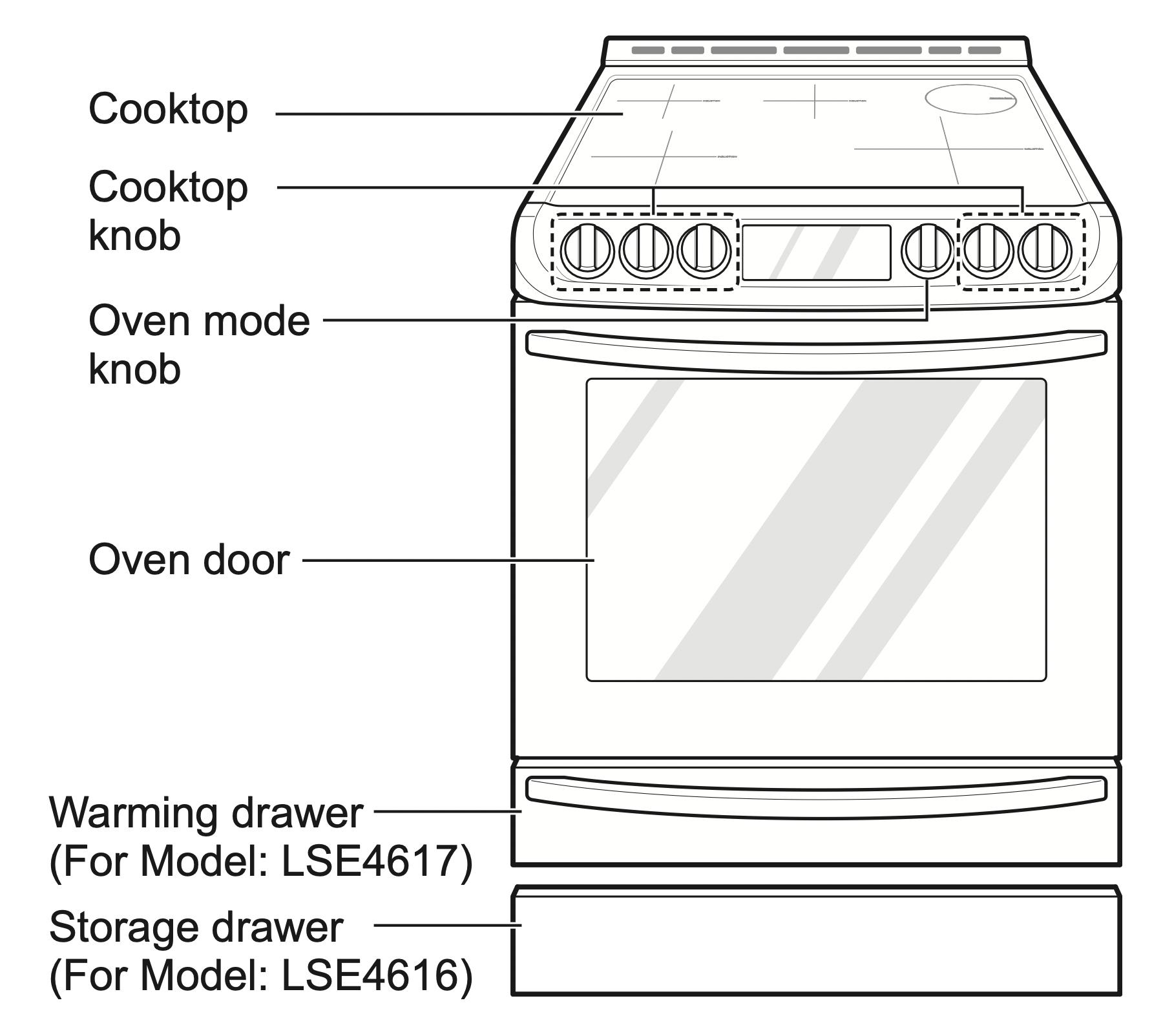

A ccessories
Included Accessories
For Model: LSE4617
- Heavy rack (2ea)

- Gliding rack (1ea)

- Meat probe (1ea)
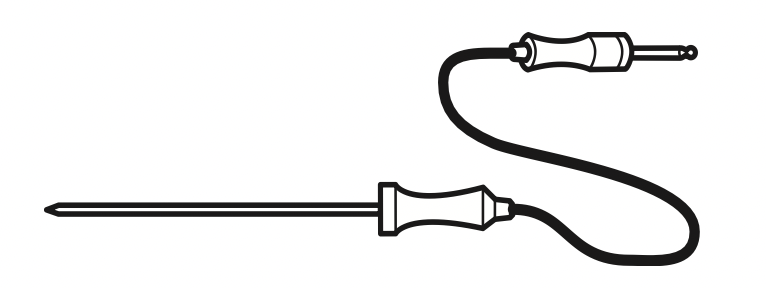
- Bottom rack (1ea)

- Cooktop cleaner (1ea)
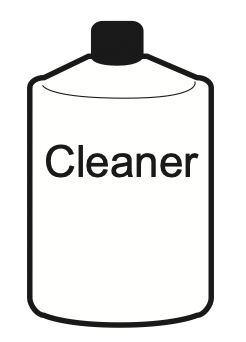
- Spray bottle (1ea)
See other models: LFXS26596S WD100CV W5J5TN4WW DLEX3700W LMV1831BD
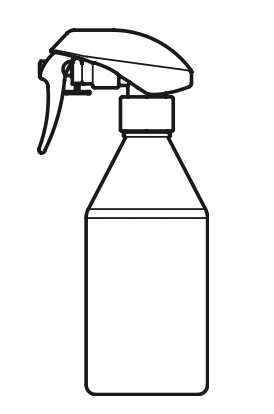
- Non-scratch scouring pad (1ea)
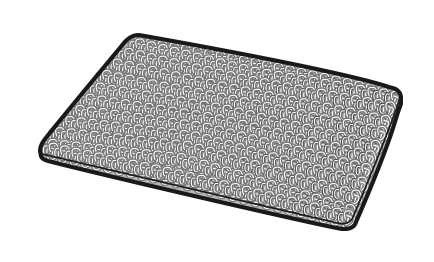
For Model: LSE4616
- Standard Rack (3ea)

- Cooktop cleaner (1ea)
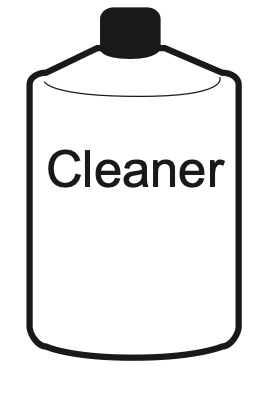
- Spray bottle (1ea)
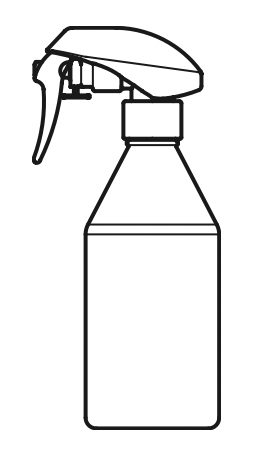
- Non-scratch scouring pad (1ea)
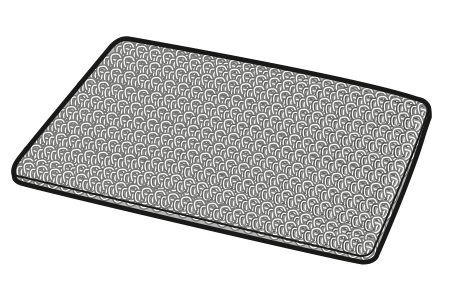
Optional Accessories
- Grid

- Broiler pan

NOTE
- For your safety and for ext ended product life, only use authorized components.
- The manufacturer is not responsible for product malfunction or accidents caused by the use of separately purchased, unauthorized components or parts.
- The images in this guide may be different from the actual components and accessories, which are subj ect to change by the manufacturer without prior notice for product improvement purposes.
OPERATION
Control Panel Overview
For Model: LSE4617
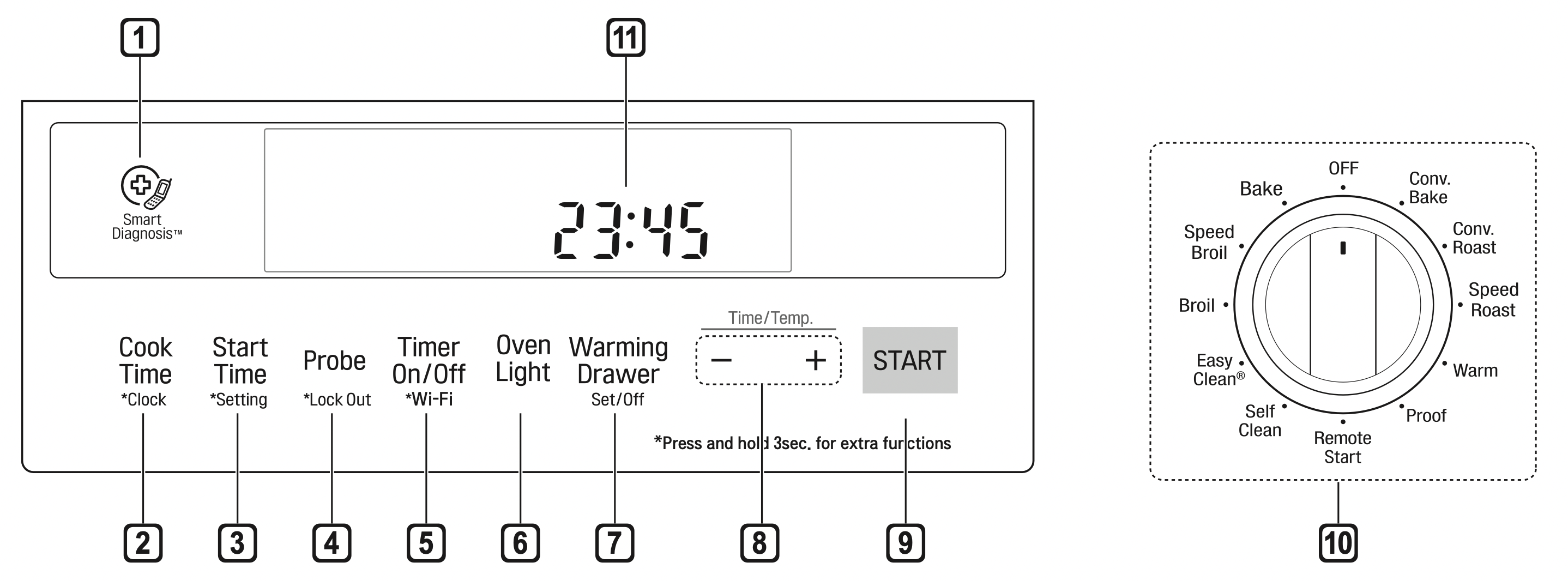
For Model: LSE4616

- Smart Diagnosis
Use during the Smart Diagnosis feature. - Cook Time / Clock ( For Model: LSE4617)
Press the button to set the desired amount of time for food to cook. The oven shuts off when the set cooking time runs out.
Press and hold button for three seconds to set the time of day. - Start Time / Setting ( For Model: LSE4617)
Press the button to set the delayed timed cook. The oven starts at the set time.
Press and hold button for three seconds to select and adj ust oven settings. - Probe / Lock Out ( For Model: LSE4617)
Press the button to select Probe function.
Press and hold button for three seconds to lock or unlock the door and control panel. - Timer On/ Off / * Wi- Fi
Press the button to set or cancel timer on oven.
Press and hold button for three seconds to connect the Wi-Fi.
To disconnect the appliance from the network, delete it from the registered appliances in the app. - Oven Light
Press the button to turn oven light on or off. - Warming Drawer ( For Model: LSE4617)
Press the button to select the warming drawer function. - - /+
Press the plus button (+ ) to increase cooking time or oven temperature.
Press the minus button (-) to decrease cooking time or oven temperature. - Start
Press the button to start all oven features. - Oven Mode Knob
Turn the knob to select oven operating mode. - Flashing Clock
If the colon in the clock display flashes, press Cook Time for three seconds and reset the clock, or press any key to stop the flashing. - Cook Time (For Model: LSE4616)
Press the button to set the desired amount of time for food to cook. The oven shuts off when the set cooking time runs out. - Start Time (For Model: LSE4616)
Press the button to set the delayed timed cook. The oven starts at the set time. - Clock / Lock Out (For Model: LSE4616)
Press button to set the time of day.
Press and hold button for three seconds to lock the door and control panel. - Setting (For Model: LSE4616)
Press button to select and adj ust oven settings.
Knob Positions
After cleaning the oven knobs, make sure to replace each knob in the correct position. Failure to do so can result in improper operation of the burners.
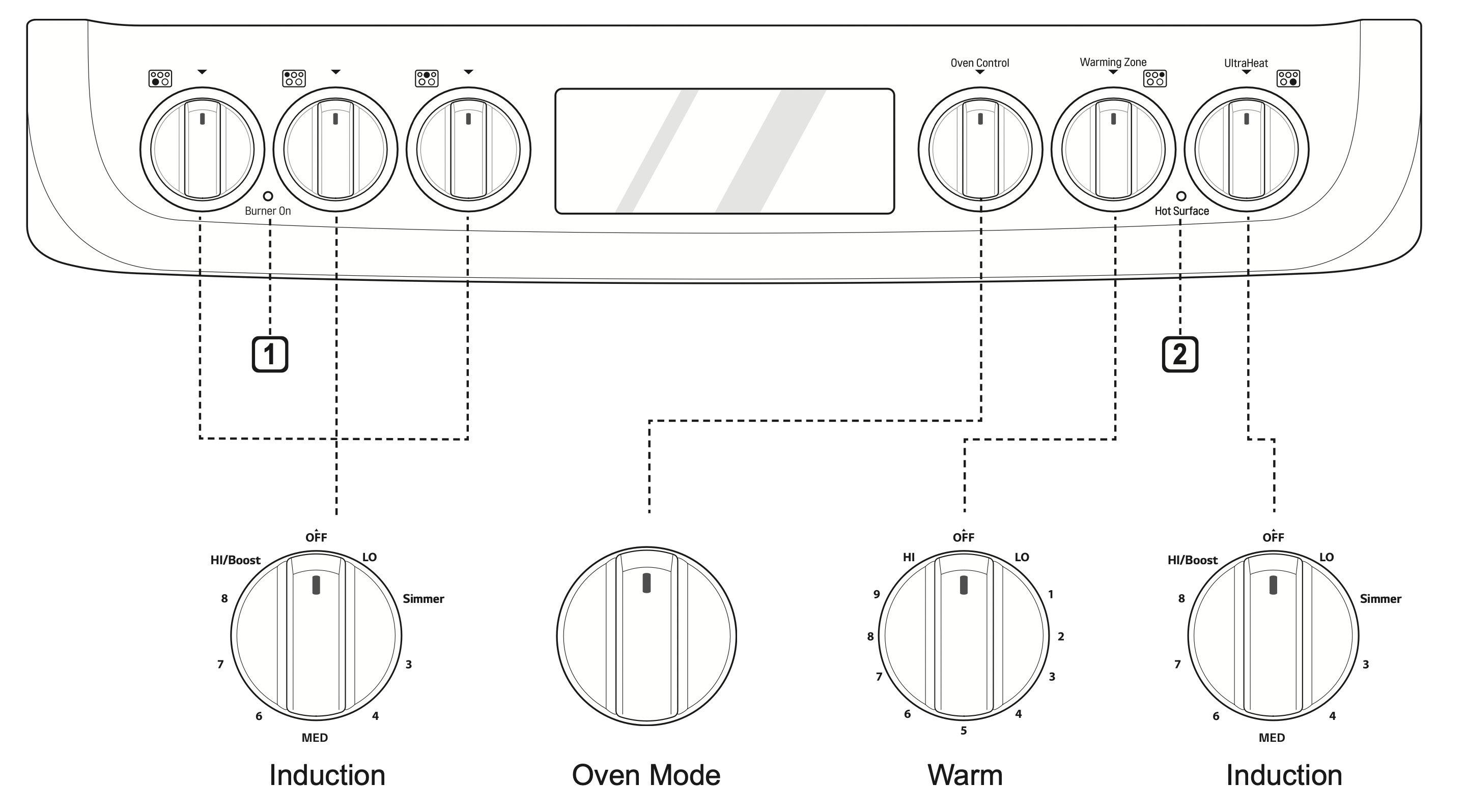
- Burner On Indicator
The Burner On indicator light turns on when the knob is turned even if the cooktop element does not operate. - Hot Surface Indicator
The hot surface indicator light glows as long as any surface cooking area is too hot to touch.
It remains on after the element is turned off and until the surface has cooled to approximately 130 ˚F.
Changing Oven Settings
Clock
The clock must be set to the correct time of day in order for the automatic oven timing functions to work properly.
- Set the oven mode knob to the Off position.
- Press and hold Cook Time for three seconds (LSE4617 model only) or press Clock. CLO shows in the display.
- Press plus ( + ) or minus ( - ) to select the desired time. Plus ( + ) to increase the time and minus ( - ) to decrease the time.
- Press Start to enter the time and start the clock.
N O T E
- The time of day cannot be changed during a timed baking or self-clean cycle.
- If no other keys are pressed within 25 seconds of pressing Clock, the display reverts to the original setting.
- If the display colon in the clock is blinking, you may have exp erienced a power failure. Reset the time.
Lockout
The Lockout feature automatically locks the oven door and prevents most oven from being turned on. It does not disable the timer and the interior oven light.
- Set the oven mode knob to the Off position.
- Press and hold Probe/ Lockout (LSE4617 model only) or Clock/ Lockout for three seconds.
- The lock melody sounds, Loc appears in the display and the lock icon
 blinks in the display.
blinks in the display. - Once the oven door is locked, the lock
 indicator stops blinking and remains on.
indicator stops blinking and remains on. - To deactivate the Lockout feature, press and hold Probe/ Lockout (LSE4617 model only) or Clock/ Lockout for three seconds. The unlock melody sounds and the door and the controls unlock.
NOTE: The Burner On indicator light turns on when the knob is turned even if the cooktop element does not operate.
Minimum & Maximum Default Settings
All of the features listed have a minimum and a maxi mum time or temperature setting that may be entered into the control. An entry acceptance beep sounds each time a control key is pressed.
An entry error tone (two short tones) sounds if the entry of the temperature or time is below the minimum or above the maximum setting for the feature.
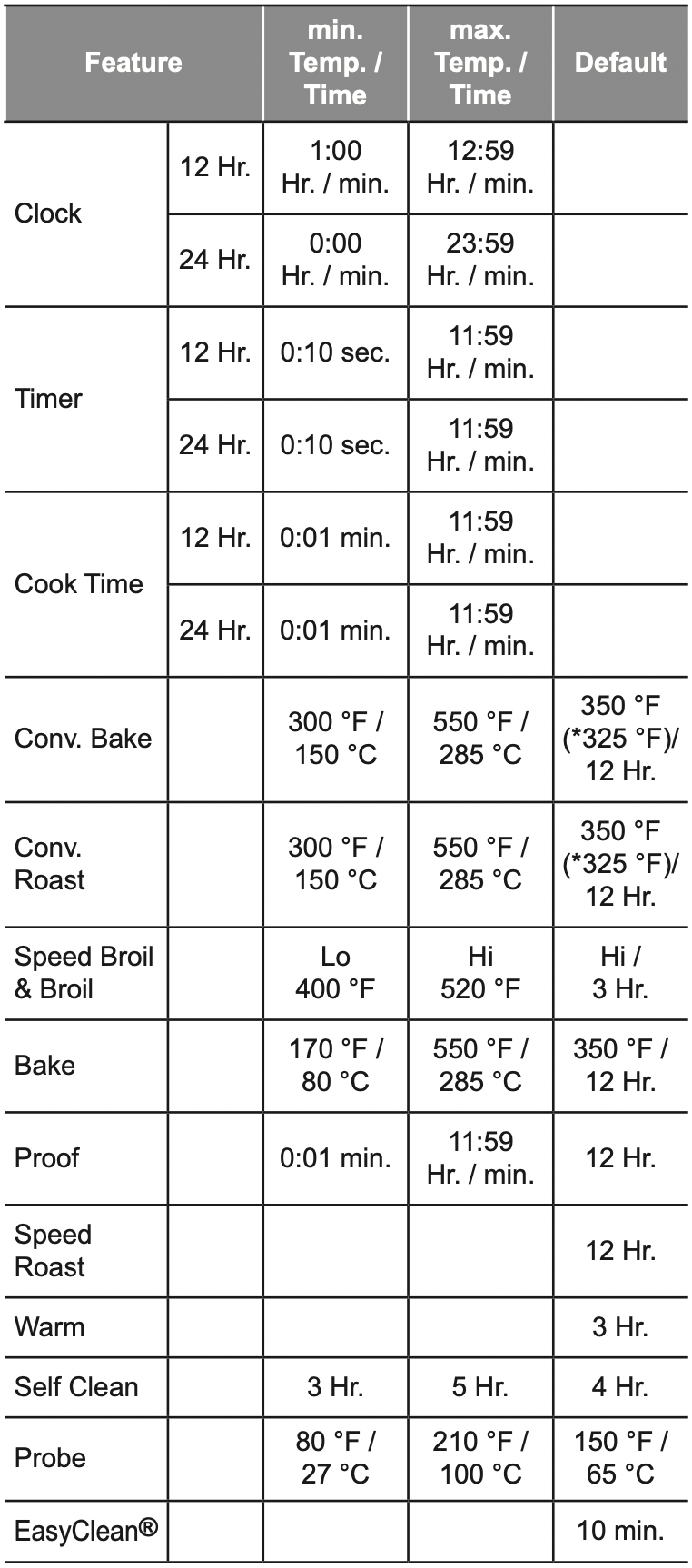
* Using Auto Conversion
- Default cook mode times are without setting cook time.
Timer On/ Off
The Timer feature serves as an ext ra timer in the kitchen that beeps when the set time has run out. It does not start or stop cooking.
The Timer feature can be used during any of the oven control functions.
Setting the Timer
- Set the oven mode knob to the Off position.
- Press Timer On/Off. 0:00 with HR inside it appears and Timer flashes in the display.
- Press plus ( + ) or minus ( - ) to set the desired time. Plus ( + ) increases the time and minus ( - ) decreases the time.
- Press Timer On/Off or Start to start the Timer. The remaining time countdown appears in the display.
NOTE: If Timer On/Off is pressed again after the timer has started, the timer function is canceled. - When the set time runs out, End shows in the display. The indicator tones sound every 15 seconds until Timer On/ Off is pressed.
NOTE
- If the remaining time is not in the display, recall the remaining time by pressing Timer On/Off.
- Press Timer On/Off twice to set the time in minutes and seconds.
- Press Timer On/Off once to set the time in hours and minutes.
Canceling the Timer
- Press Timer On/Off once.
The display returns to the time of day.
Wi-Fi
The Wi-Fi button is used to connect the appliance to a home Wi-Fi network.
- Set the oven mode knob to the Off position.
- Press and hold Timer On/Off for 3 seconds.
- The power on chime sounds, SEt appears in the display, and the Wi-Fi icon (
 ) blinks.
) blinks. - Register the appliance on the Wi-Fi network using the smart phone app.
- To disconnect the appliance from the network, delete it from the registered appliances in the app.
NOTE: See the Smart Functions section in the owner’s manual for more details.
Settings
Set the oven mode knob to the Off position.
Press and hold Start Time for three seconds (LSE4617 model only) or press Setting.
Then press the Start Time (LSE4617 model only) or Setting key repeatedly to toggle through and change oven settings.
The Setting key allows you to:
- set the hour mode on the clock (12 or 24 hours)
- enable/ disable convection auto conversion
- adjust the oven temperature
- activate/ deactivate the preheating alarm light
- set the beeper volume
- switch the temperature scale between Fahrenheit and Celsius
- activate/ deactivate the cooktop beeper
Setting the Hour Mode
The control is set to use a 12-hour clock. To reset the clock to 24-hour mode, follow the steps below.
- Set the oven mode knob to the Off position.
- Press and hold Start Time for 3 seconds (LSE4617 model only) or press Setting.
- Press plus ( + ) or minus ( - ) to set the desired hour mode on the clock.
- Press Start to accept the desired change.
Setting Convection Auto Conversion
When Conv. Bake and Conv. Roast are selected, Convection Auto Conversion automatically converts the standard recipe temperature entered to a convection temperature by subtracting 25°F / 14°C. This auto-converted temperature shows on the display. For example, select Conv. Bake, enter 350°F, and 325°F shows on the display after preheat.
Convection Auto Conversion is enabled by default. To change the setting, follow these instructions.
- Set the oven mode knob to the Off position.
- Press and hold Start Time for 3 seconds (LSE4617 model only) or press Setting. Then press Start ime (LSE4617 model only) or Setting repeatedly until “
 ” appears in the display.
” appears in the display. - Press plus ( + ) or minus ( - ) to turn the feature on/ off.
- Press Start to accept the change.
Adjusting the Oven Temperature
Your new oven may cook differently from the one it replaced. Use your new oven for a few weeks to become more familiar with it before changing the temperature settings. If after familiarizing yourself with the new oven, you still think that it is too hot or too cold, you can adjust the oven temperature yourself.
NOTE: To begin, either raise or lower the thermostat 15°F (8°C). Try the oven with the new setting. If the oven still needs adjustment, raise or lower the thermostat again, using the first adj ustment as a gauge. For example, if the adjustment was too much, raise or lower the thermostat 10°F (5°C). If the adjustment was not enough, raise or lower the thermostat 20°F (12°C). Proceed in this way until the oven is adj usted to your satisfaction.
- Set the oven mode knob to the Off position.
- Press and hold Start Time for three seconds (LSE4617 model only) or press Setting. Then press Start Time (LSE4617 model only) or Setting repeatedly until “
 ” appears in the display.
” appears in the display. - To increase the temperature, press plus ( + ) until the desired amount appears in the display.
- To decrease the temperature, press minus ( - ) until the desired amount appears in the display.
- Press Start to accept the change.
NOTE:
- This adjustment does not affect the broiling or Self Clean temperatures. The adjustment is retained in memory after a power failure. The oven temperature can be increased (+) or decreased (-) as much as 35°F or 19°C.
- Once the temperature is increased or decreased, the display shows the adj usted temperature until it readj usts.
Turning the Preheat Alarm Light On/Off
When the oven reaches its set-temperature, the preheating alarm light flashes 5 times or until the oven door is opened.
- Press and hold Start Time for three seconds (LSE4617 model only) or press Setting. Then press Start Time (LSE4617 model only) or Setting repeatedly until “
 ” appears in the display.
” appears in the display. - Press plus (+) or minus (-) to turn the light on/off.
- Press Start to accept the change.
Adjusting the Oven Beeper Volume
- Set the oven mode knob to the Off position.
- Press and hold Start Time for three seconds (LSE4617 model only) or press Setting. Then press Start Time (LSE4617 model only) or Setting repeatedly until “
 ” appears in the display.
” appears in the display. - Press plus (+) or minus (-) to select the desired volume.
- Press Start to accept the change.
Selecting Fahrenheit or Celsius
Set the oven temperature display to show either Fahrenheit (°F) or Celsius (°C) units. The oven defaults to Fahrenheit unless changed by the user.
- Set the oven mode knob to the Off position.
- Press and hold Start Time for three seconds (LSE4617 model only) or press Setting. Then press Start Time (LSE46 1 7 model only) or Setting repeatedly until “
 ” appears in the display.
” appears in the display. - Press plus (+) or minus (-) to select F (Fahrenheit) or C (Centigrade).
- Press Start to accept the change.
Turning the Cooktop Beeper On/Off
- Set the oven mode knob to the Off position
- Press and hold Start Time for three seconds (LSE4617 model only) or press Setting. Then press Start Time (LSE4617 model only) or Setting repeatedly until “
 ” appears in the display.
” appears in the display. - Press plus (+) or minus (-) to turn the beep on/ off.
- Press Start to accept the change.
Start Time ( Delayed Timed Cook)
The automatic timer of the Delayed Timed Cook function turns the oven on and off at the time you select. This feature can be used with the Bake, Conv. Bake and Conv. Roast modes.
Setting a Delayed Timed Cook
For example, to bake at 300°F and delay the start of baking until 4 h 30 m, first set the clock for the correct time of day.
- Turn the oven mode knob to select the Bake mode. 350 °F appears in the display.
- Set the temperature: press minus (-) until 300°F appears in the display.
- Press Cook Time and press plus (+) or minus (-) to set the baking time.
- Press Start Time.
- Set the start time: press plus (+) until HR4: 30 appears in the display.
- Press Start. A short beep sounds and Timed Delay and the start time appear in the display. The oven begins baking at the set start time.
NOTE:
- To cancel the Delayed Timed Cook function, turn the oven mode knob to the Off position.
- To change the cooking time, repeat step 3 and press Start.
- If the oven clock is set as a 12-hour clock, you can delay the cook time for 12 hours. If the oven clock is set as a 24-hour clock, you can delay the cook time for 24 hours.
The oven will continue to cook for the set amount of time and then turn off automatically. When the cooking time has elapsed:
- End and the time of day show in the display.
- The cook end indicator tone sounds every 60 seconds until the oven mode knob is turned to the Off position.
CAUTION:
- Use the automatic timer when cooking cured or frozen meats and most fruits and vegetables. Foods that can easily spoil, such as milk, eggs, fish, meat or poultry, should be chilled in the refrigerator. Even when chilled, they should not stand in the oven for more than 1 hour before cooking begins, and should be removed promptly when cooking is completed.
- Eating spoiled food can result in sickness from food poisoning.
Cook Time ( Timed Cook)
Set the oven to cook for a specific length of time using the Timed Cook feature. This feature can only be used with the Bake, Conv. Bake and Conv. Roast modes.
Setting the Cook Time Function
For example, to bake at 300°F for 30 minutes, first set the clock to the correct time of day.
- Turn the oven mode knob to select the Bake mode. 350°F appears in the display.
- Set the oven temperature. For this example, press minus (-) until 300°F appears in the display.
- Press Cook Time. Timed flashes in the display. Bake, 0:00 and 300°F appear in the display.
- Set the baking time: press plus (+) until 30:00 appears in the display. The baking time can be set for any amount of time between 1 minute and 11 hours and 59 minutes.
- Press Start.
The oven will continue to cook for the set amount of time and then turn off automatically. When the cooking time has elapsed:
- End and the time of day show in the display.
- The cook end indicator tone sounds every 60 seconds until the oven mode knob is turned to the Off position.
Changing the Cook Time during Cooking
For example, to change the cook time from 30 minutes to 1 hour and 30 minutes, do the following.
- Press Cook Time.
- Change the baking time: press plus (+) until 1 hour and 30 minutes appears in the display.
- Press Start to accept the change.
Oven Light
The interior oven light automatically turns on when the door is opened. Press Oven Light to manually turn on/ off the oven light.
NOTE: The oven light cannot be turned on if the Self Clean function is active.
Using the Cooktop
Cooking Areas
The cooktop is equipped with four induction cooking elements of different sizes and a radiant heat warming zone. The wattage ratings below are maxi mum outputs. The second rating is the maxi mum output for Boost mode.
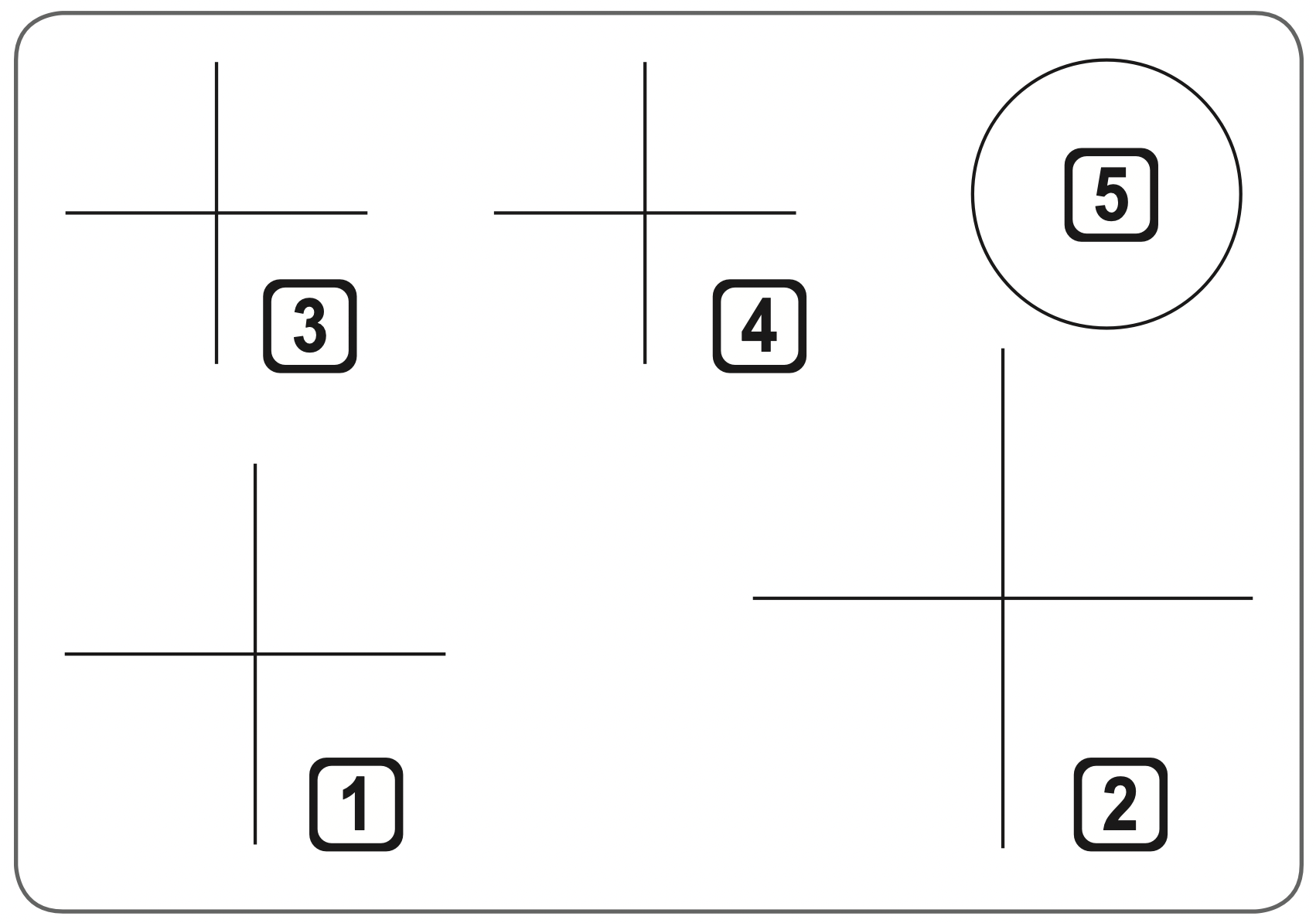
- Induction left front cooking element: 8", 2100W/3200W (240V)
- Induction right front cooking element: 11", 2400W/4000W (240V)
- Induction left rear cooking element: 6", 1300W/1800W (240V)
- Induction center rear cooking element: 6", 1300W/1800W (240V)
- Warming zone
There are LED displays under each induction cooking element which adjust to show the power level when the element is used.
Benefits of Induction Surface Cooking
Speed and Efficiency
Induction cooking elements heat faster and use less energy. Induction power levels quickly boil liquids and are efficient when simmering.
A Cooler Cooktop
Whether induction cooking elements are turned on or off, they remain cooler than radiant elements. Virtually no heat is wasted because the heat begins with the presence of cookware.
Easy Cleanups
Cooler cooking elements make for easier cleaning. Spills resist sticking or burning so they wipe up easily.
Pan Size Detection
A sensor automatically detects and adapts the induction cooking element to the pan size in use for more consistent, even cooking.
Greater Responsiveness
Induction cooking elements are more responsive than their electric or gas counterparts because only the pan heats. Induction elements heat more easily and are just as responsive when reducing temperatures to a simmer.
Induction Cookware
NOTE: Before using the induction cooking elements, carefully read and follow these cookware recommendations and the instructions in the pan sensing sections.
When purchasing pans for use on the induction cooktop, look for cookware identified by the manufacturer as "induction ready" or "induction capable" , or that is marked by the manufacturer as specifically designed for induction cooking.
The base material of the cookware must be magnetic for the cooking elements to activate. Use a magnet to check if the cookware base material is suitable. If the magnet sticks to the bottom of the cookware, the cookware can be used for induction cooking.
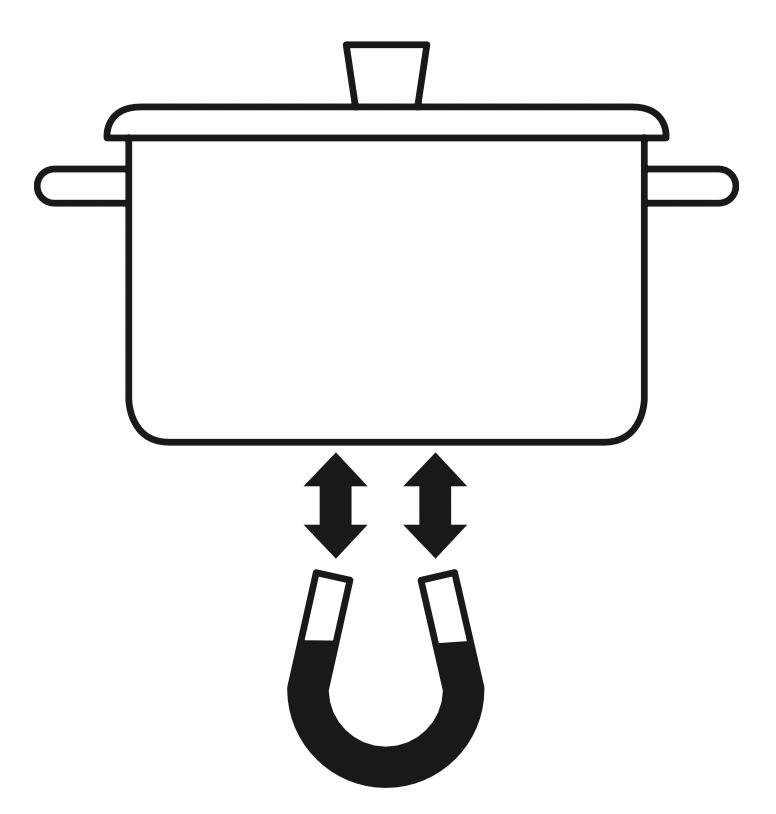
For the best possible surface cooking results, use only high-quality, heavy gauge steel cookware on the induction cooking elements. Follow manufacturer's recommendations when using induction cookware.
Induction Cookware Types 
The three most common induction cookware types available are stainless steel, cast iron, and porcelain-enamel- coated metals.
- Stainless Steel is generally excellent for induction cooking. It is durable, easy to clean, and resists staining.
NOTE: Not all stainless steel cookware is magnetic; stainless steel is not always suitable for induction cooking.
- Cast iron cooks evenly and is also good for induction cooking. Do not slide cast iron cookware on the cooktop; cast iron cookware with a rough surface will scratch the ceramic cooktop.
- Porcelain-enamel-coated metals have variable heating characteristics depending on the quality of the base metal. Make sure the porcelain-enamel coating is smooth to avoid scratching the ceramic cooktop.
Cookware Placement
Use the proper cookware and place it correctly on the cooktop. One or more of the cooking elements will not heat if any of the incorrect conditions shown is detected by the sensors located below the ceramic cooktop surface. Correct the problem before attempting to use the cooktop.
Correct
- Cookware is centered correctly on surface of cooking element.
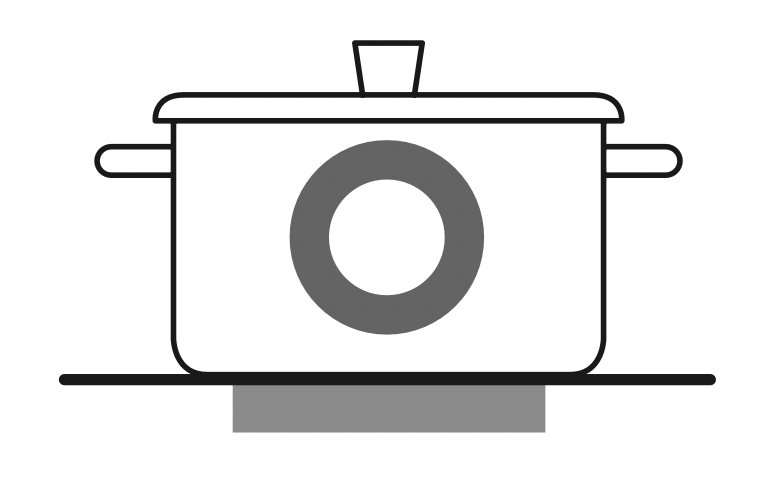
- Pan has flat bottom and straight sides.
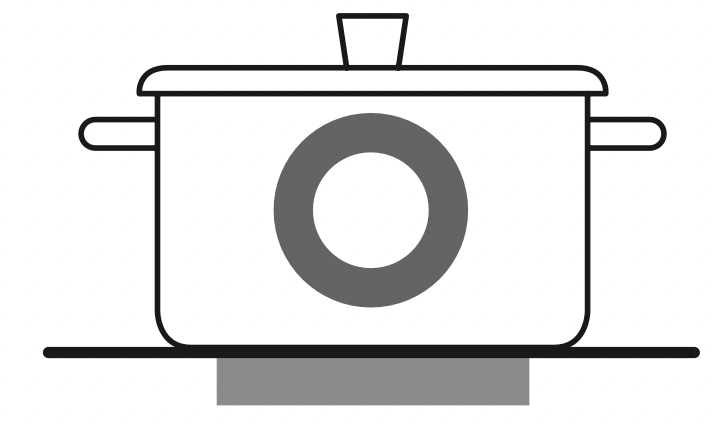
- Pan size meets or exceeds the recommended minimum size for the cooking element.
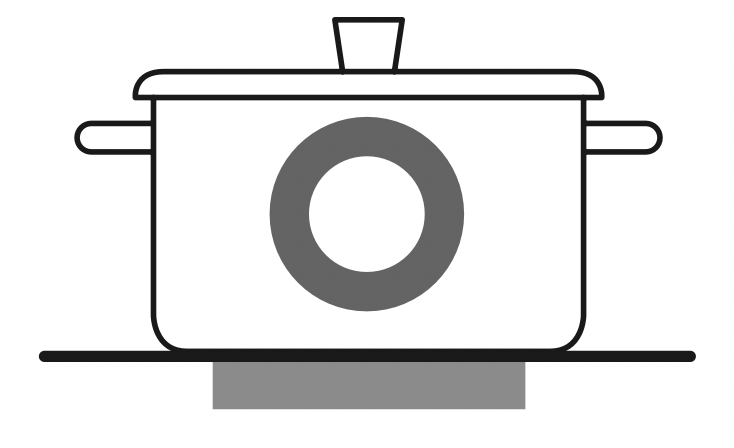
- Pan rests completely on the cooktop surface.
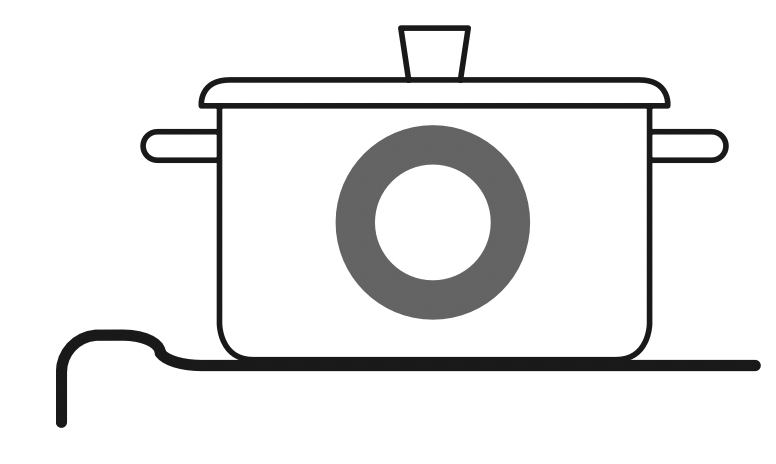
- Pan is properly balanced.
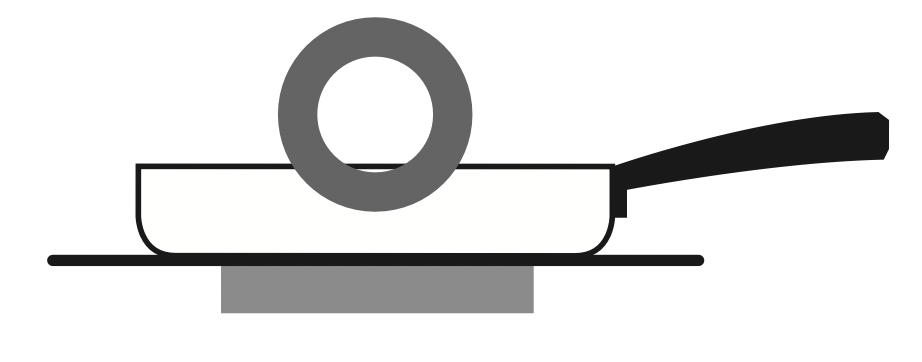
Incorrect
- Cookware is not centered on surface of cooking element.
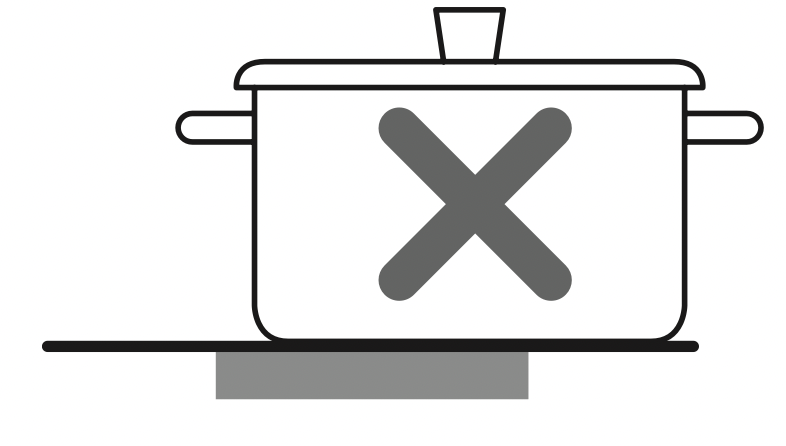
- Pan has curved or warped bottom or sides.
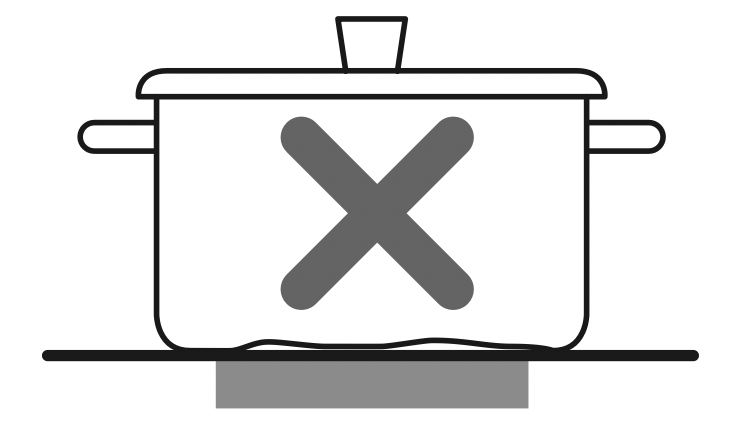
- Pan does not meet the minimum size required for the cooking element used.

- Pan bottom rests on cooktop trim or does not rest completely on the cooktop surface.
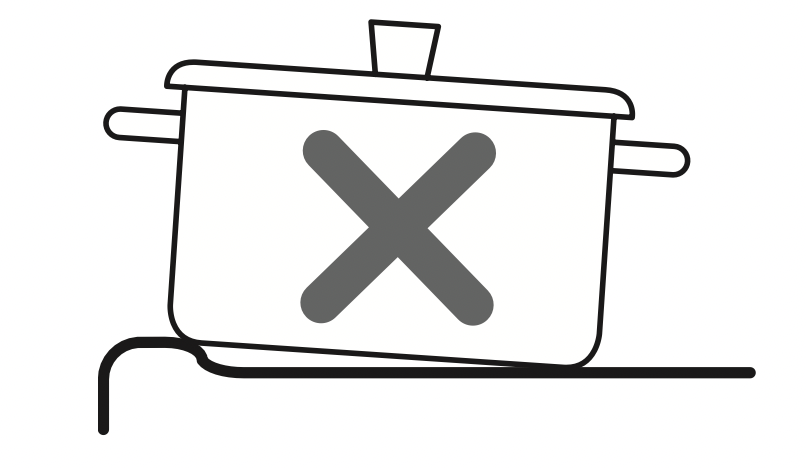
- Pan is unbalanced by heavy handle.
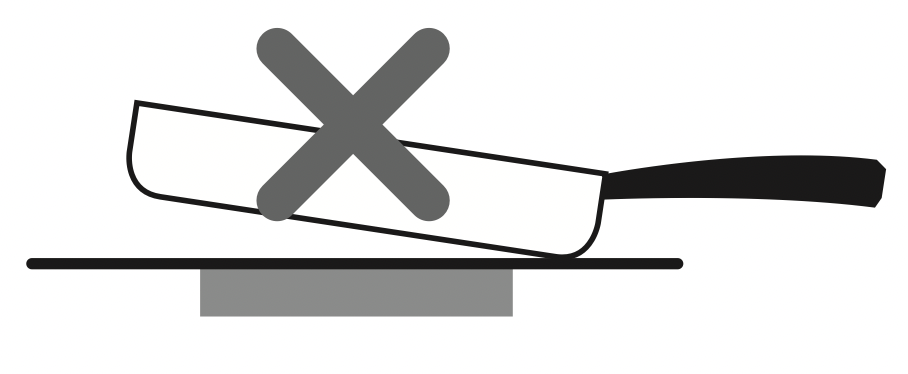
Moving Cookware on the Cooktop
Always use heavier gauge, high-quality cookware on the cooking elements and do not slide it on the ceramic cooktop surface. Even high-quality cookware can scratch the cooktop surface.
NOTE
- Always lift cookware before moving it on the ceramic glass surface. Any cookware that has a rough or dirty bottom can mark and scratch the cooktop surface. Always start with clean cookware.
- Do not allow aluminum foil or any material that can melt to make contact with the ceramic glass cooktop. If these materials melt on the cooktop they may damage the ceramic glass surface.
Sliding any type of cookware over the surface will scratch the cooktop over time. Scratches will make cleaning the ceramic cooktop difficult and degrade the appearance of the cooktop.
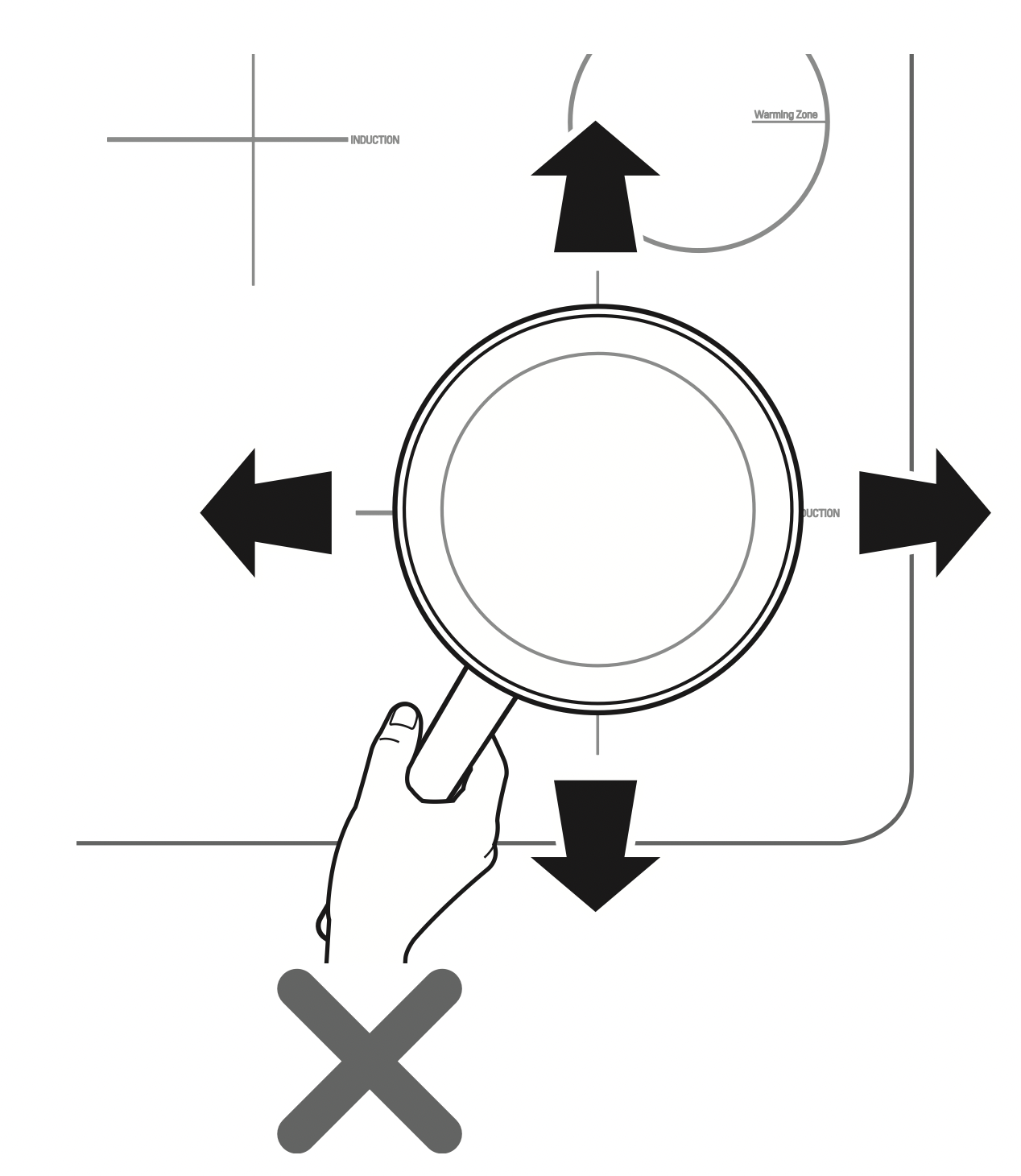
Pan Sensing
The cooking-element sensors located below the cooktop surface require certain cookware conditions to be met before the induction cooking elements can operate.
The cooking zone LED bar may display a pan sensing error message. If a cooking element is activated and no cookware is detected, the affected induction cooking zone LED bar will fluctuate. If the cookware does not meet the correct conditions, the cooking zone may not heat.

If the problem is not corrected, the affected cooking element will automatically deactivate after one minute.
Minimum and Maximum Pan Size
There are four cooking elements on the induction cooktop. Each element requires a minimum pan size to be used effectively. The inner ring of each cooking element is a guide to the minimum pan size.
The bottom of the pan must fully cover the inner ring for proper cooking to occur.
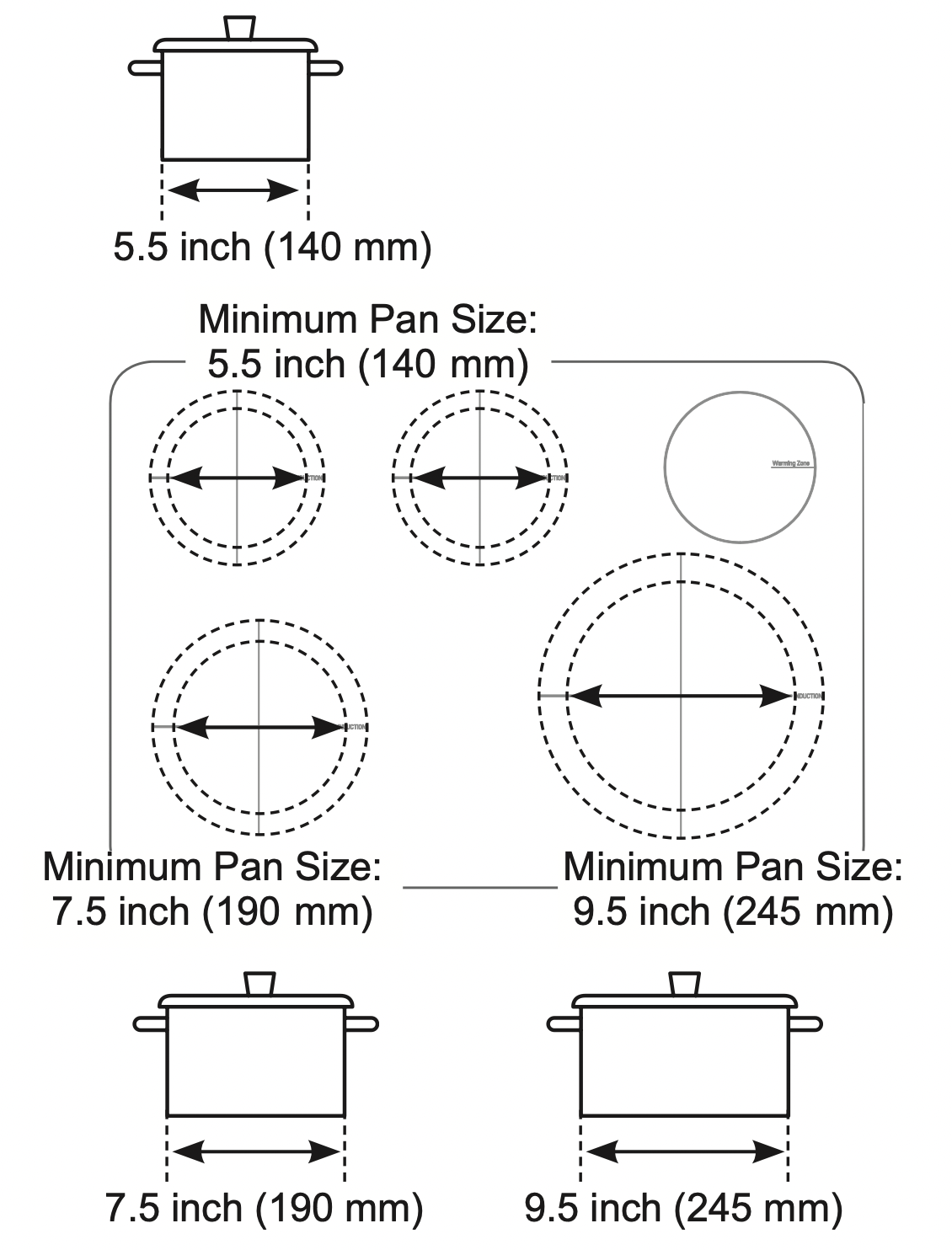
Use the cross that marks each cooking element to help determine the max imum pan size. After centering the cookware on the cooking element, the cookware should not extend more than ½ʺ beyond the edge of the cross on the cooking element. The pan must make full contact with the glass surface without the bottom of the pan touching the metal cooktop trim.

If the correct induction cookwarece ntered on any of the active cooking elements is too small, the affected cooking element’s LED bar fluctuates and the pan does not heat.
Hot Cookware and Residual Heat
CAUTION: Unlike radiant surface elements, induction cooking elements do not glow red when hot. You can be burned if the glass surface is hot from the residual heat transferred from the cookware. Do not touch hot cookware or pans. Use oven mitts or potholders to protect hands from burns.
Home Canning
CAUTION: Canning can generate large amounts of steam. Use ext reme caution to prevent burns. Raise the lid so that steam is vented away from you. Safe canning req uires that harmful micro-organisms are destroyed and jars are sealed completely. When using a water bath canner, maintain a gentle but steady boil for the required time.
Read and observe the following precautions when home canning. Read the information on the USDA (United States Department of Agriculture) website and follow the recommendations there for home canning procedures.
- Use only quality, flat-bottomed canners when home canning. Use a ruler to check the bottom of the canner for flatness.
- Canners with ridges that radiate from the bottom center are not suitable for use on a ceramic glass cooktop.
- The diameter of the canner should not exce ed the maxi mum cooking element markings by more than one inch. Use smaller diameter canners on ranges with ceramic-glass or open-coil-electric cooktops.
- Start with hot tap water to boil water more quickly.
Bring water to an initial boil using the highest heat setting. Once the water is boiling, reduce the heat as much as possible while maintaining the boil. - It is best to can small amounts and keep the canner light enough to lift.
- Do not leave the water bath or pressure canners on high heat for ext ended periods.
- Alternate surface elements between each batch to allow the elements and surrounding surfaces to cool down. Do not can using the same element all day.
Setting Surface Controls
- Cooking Element LED Bar
The range provides an LED bar for each cooking element on the cooktop. Check messages in the display window and use the LEDs with the corresponding control knobs to monitor the power levels of the elements.
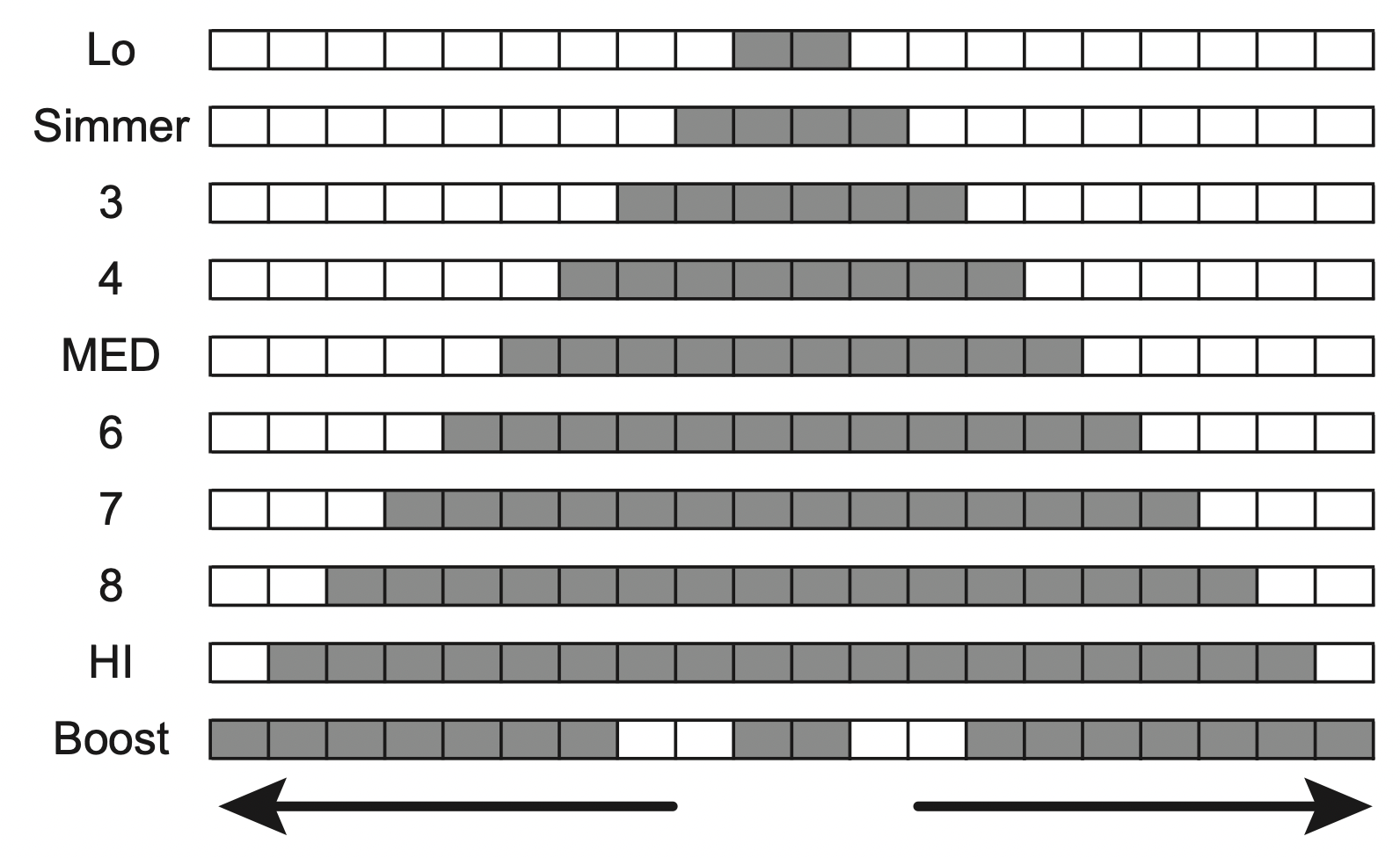
- Available Power Level Settings
The cooktop control’s LED bar displays the element’s power level settings, ranging from Lo to Hi to Boost. Adjust the settings in increments of one, from Lo (Level 1) to Boost (Level 10).
To select Hi, turn the knob clockwise, through level 8 to Hi/ Boost. - Boost Power Level
To activate the Boost mode, turn the knob directly from Off to Boost. Boost mode is only available immediately after activating a cooking element. When the cooking element is set to the Boost mode, the LED bar flashes and the Boost mode stays in operation for up to 10 minutes. After 10 minutes, the cooking element automatically returns to the Hi setting.
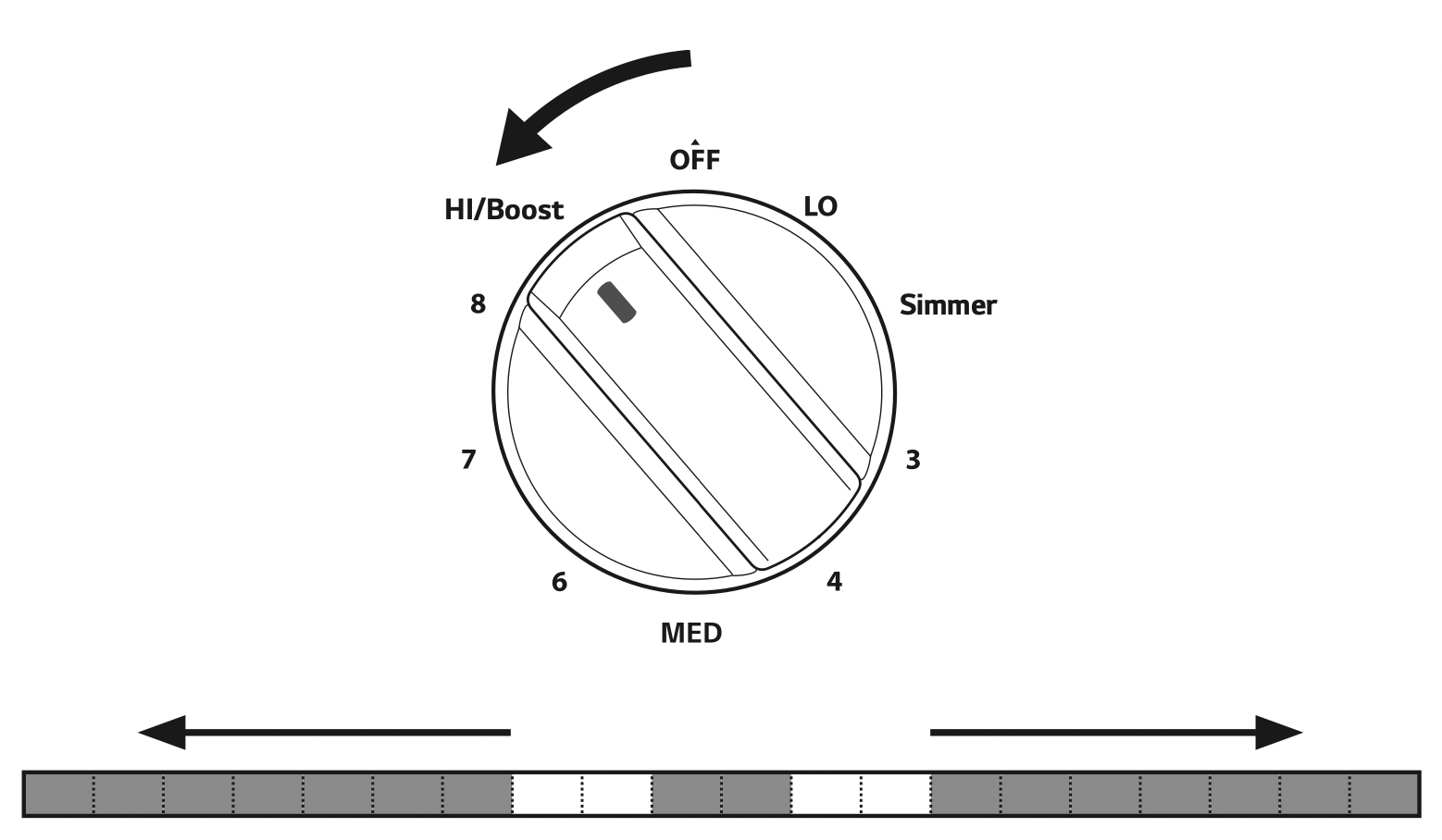
The maximum operating time for all element levels except the Boost mode is 12 hours.
Hot Surface Indicator
The hot surface indicator light glows as long as any surface cooking area is too hot to touch.
It remains on after the element is turned off and until the surface has cooled to approximately 130 °F.
It is normal for the surface elements to cycle on and off when cooking at lower temperature settings.
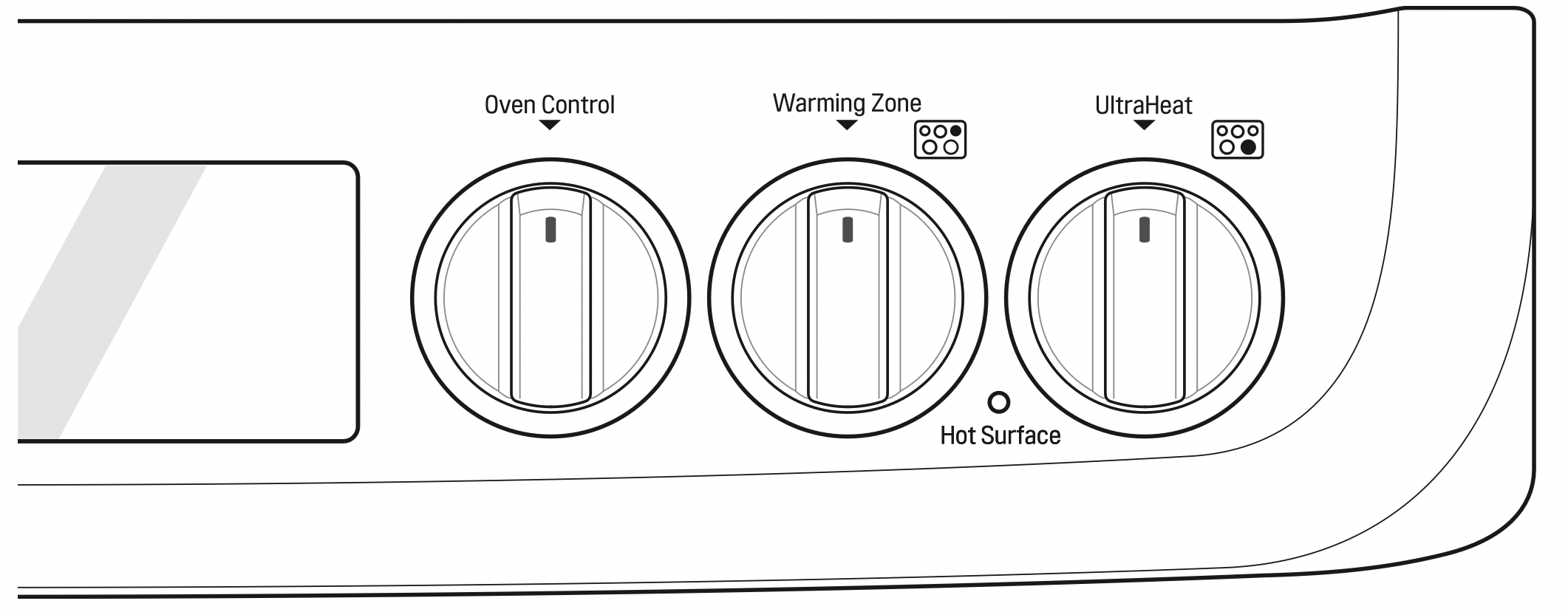
Using the Cooking Elements
CAUTION:
Before Cooking
- Do not place or store flammable or heatsensitive items on the induction cooktop, even when the cooktop is not in use.
- Place cookware on the cooking elements before turning on the induction cooktop.
- Do not place sealed containers on the cooktop.
During Cooking
- Do not place metallic objects such as knives, forks, spoons, and lids on the induction cooktop surface; they can get hot.
- Use this appliance only for normal household use. It is not designed for commercial or industrial use.
- Never use the appliance to heat the room.
- Use caution when plugging electrical appliances into power outlets near the cooktop. Keep power cords from any contact with the cooktop or cookware.
- Overheated fat and oil can catch fire quickly.
Never leave surface elements unattended when frying foods. - Do not use the induction cooktop to heat aluminum foil, products wrapped in aluminum foil , or frozen foods packaged in aluminum cookware.
- Use caution when plugging electrical appliances into outlets near the cooktop to keep power cords away from the hot cooktop or cookware.
- Users with pacemakers and active heart implants must keep their upper body at a minimum distance of 1ft (30 cm) from active induction cooking elements. If in doubt, consult the implant manufacturer or your doctor.
After Cooking
- After use, switch off the induction cooking element using its control. Do not rely on the pan sensor.
Turning On Cooking Elements Except Warming Zone)
- Push the control knob in.
- Turn the knob in either direction to select the desired setting. A short beep sounds and the cooking element’s LED bar shows its current setting.
- To activate the Boost mode, turn the knob directly from Off to Boost.
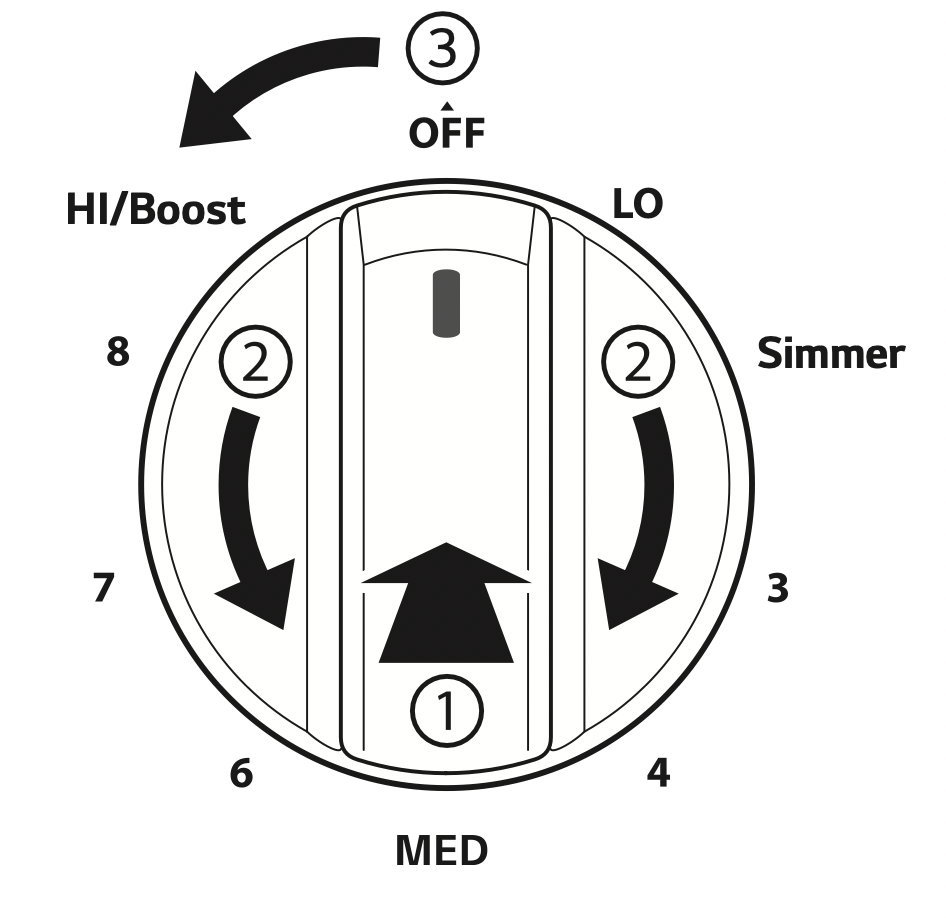
The Recommended Surface Cooking Setting
Start most surface cooking on a higher setting and then adjust to a lower setting to finish cooking.
The suggested settings may need adjustments, depending on cookware design and quality and on the amount of food being prepared.
Use quality cookware that is constructed with a magnetic base material and that meets the minimum and maximum pan size requirements.
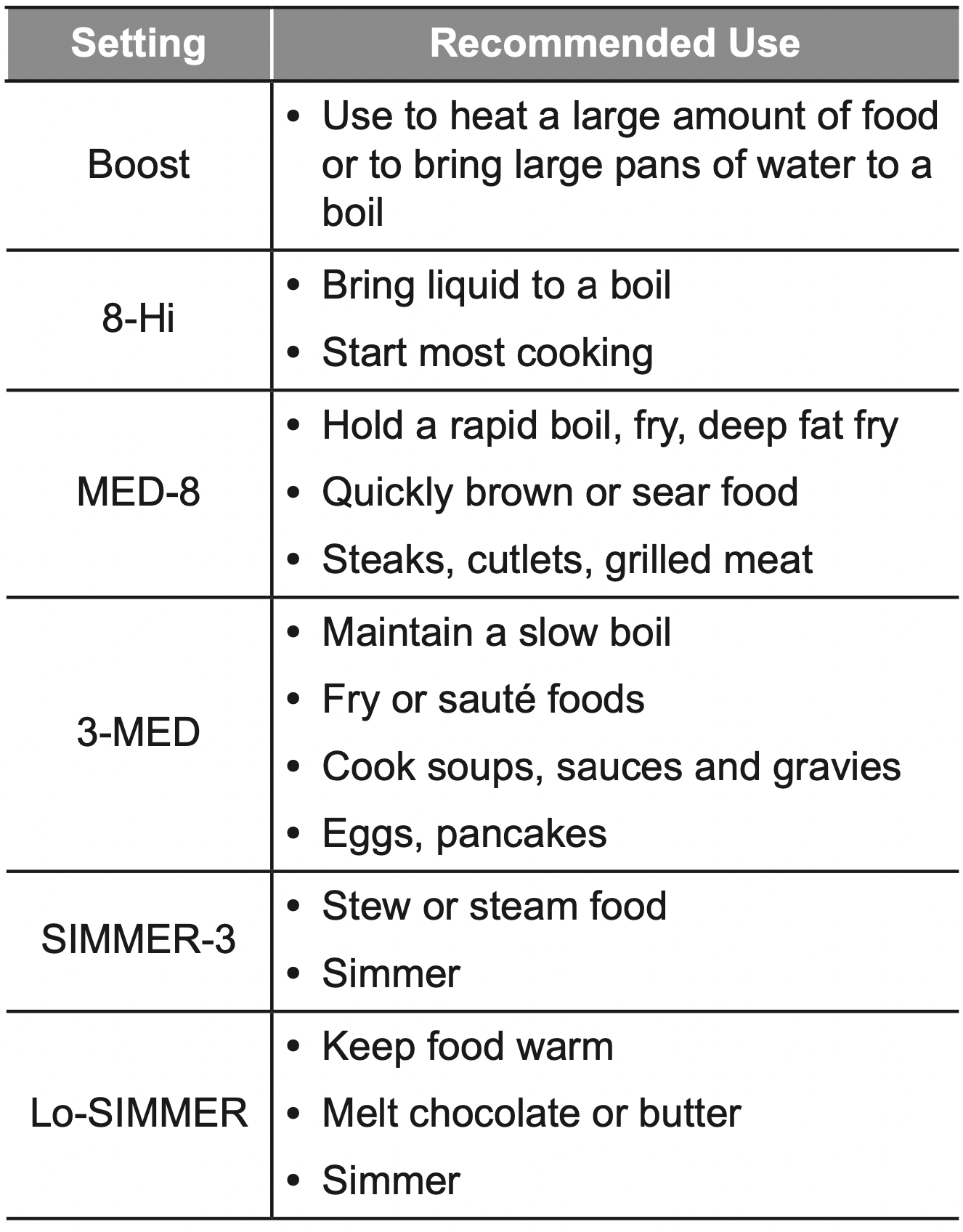
Pan Preheat Recommendations
Induction cooking may decrease the amount of time req uired to preheat cookware compared to cooking on a radiant element cooktop or gas surface burner.
Pay close attention to all food items while cooking on the cooktop or in the oven, and until all cooking processes are complete.
CAUTION: Remember that induction surface cooking initially heats the cookware VERY QUICKLY if the cookware does not contain food.
Noises during Cooktop Operation
The electronic processes involved with induction cooking may create some background noises. You may hear a slight buzzing sound when cooking on the cooktop. These noises are part of the induction cooking process and are considered normal.
Some cookware will buzz, depending on the construction or base material. The buzz may be more noticeable if the contents of the pan are cold. As the pan heats up, the noise will decrease. The noise will also decrease if the power level setting is reduced.
NOTE:
- When using the induction cooktop, operational noises are more noticeable while cooking in Boost mode. But very loud noises are not normal when induction cooking.
- The cooktop fan may turn on to reduce the temperature of the product, even when the surface elements are not being used.
Power Management
The cooking zones, which consist of paired cooking elements, are restricted to drawing a certain maximum amount of power.
If you turn on the Boost function for one element while its paired element is in use, the Power Management function may automatically reduce the power of both elements. For consistent performance when using multiple elements, use elements in separate cooking zones.
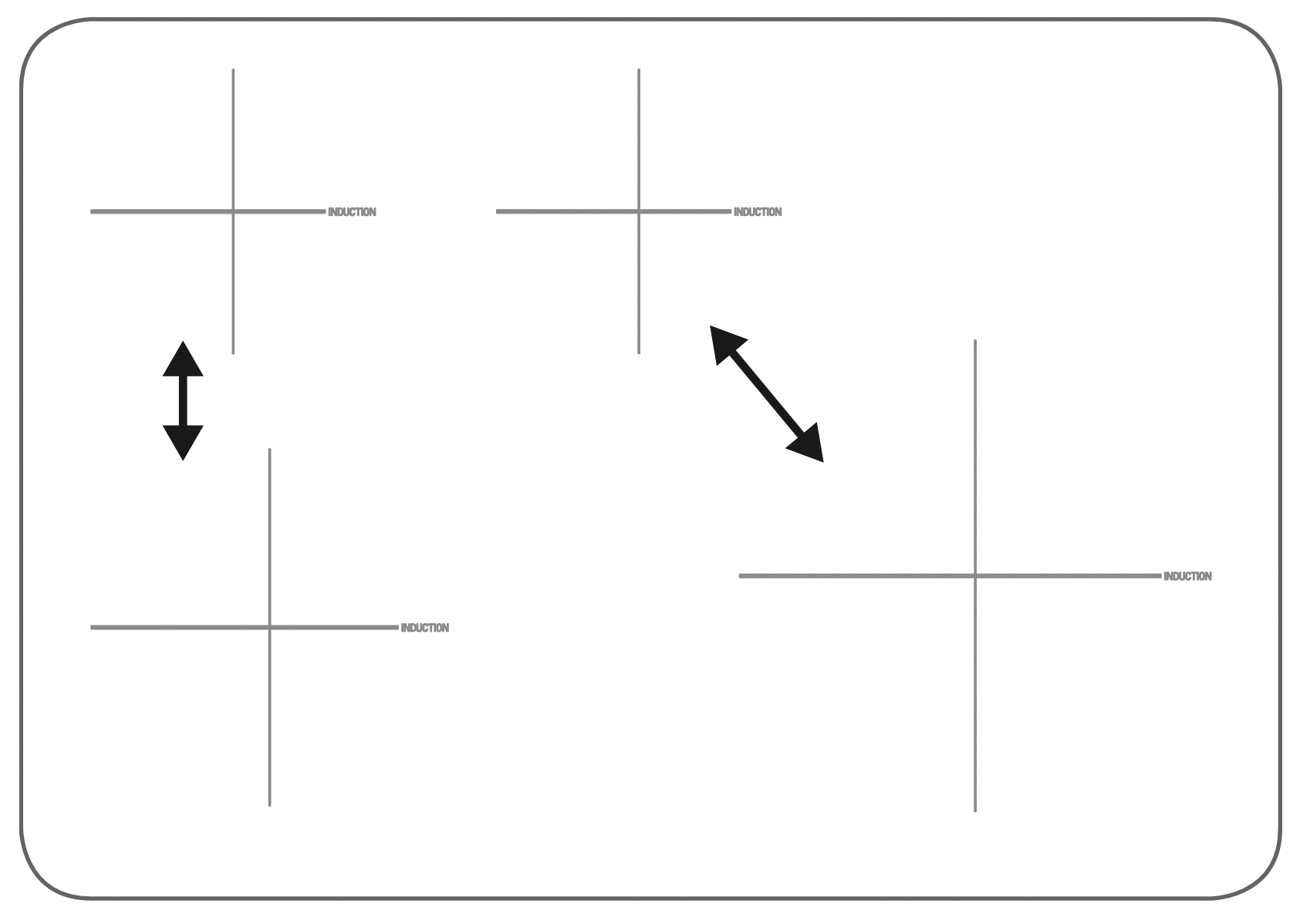
NOTE:
- If the combined heat of the oven and the surface burners is sufficiently high, the output of the surface burners is reduced to avoid damage to the product.
- Both elements in a set of paired elements cannot use the Boost mode at the same time. To use the Boost mode on two elements simultaneously, use non-paired elements.
Warming Zone
Use the Warming Zone, located in the back right of the glass surface, to keep hot, cooked food at serving temperature. The Warming Zone keeps food warm after it has already been cooked. Attempting to cook uncooked or cold food on the Warming Zone could result in a food-borne illness.
CAUTION:
FOOD POISON HAZARD: Bacteria may grow in food at temperatures below 140 °F.
- Always start with hot food. Do not use the warm setting to heat cold food.
- Do not use the warm setting for more than two hours.
Turning On Warming Z one
- Push the control knob in.
- Turn the knob in either direction to select the desired setting.
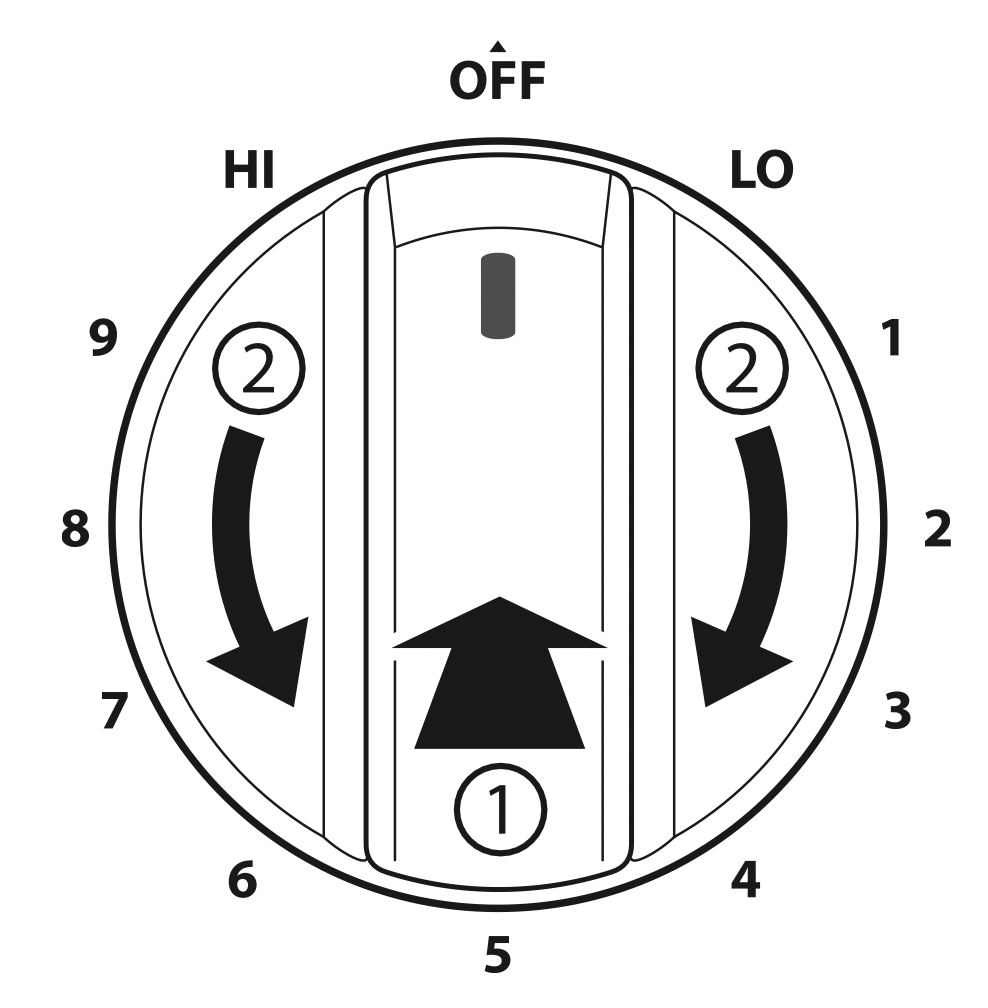
For best results :
- When warming pastries or breads, leave an opening in the cover to allow moisture to escape.
- Do not use plastic wrap to cover food. Plastic may melt onto the surface and be very difficult to remove.
- Use only dishware, utensils and cookware that is recommended for oven and cooktop use.
NOTE:
- For best results, food on the Warming Zone should be kept in its container or covered with a lid or aluminum foil to maintain food quality.
- Do not allow aluminum foil to contact the hot induction cooktop surface.
If a particular food is not listed, start with the medium heat level and adj ust as needed. Most foods can be kept at serving temperatures by using the medium heat level.
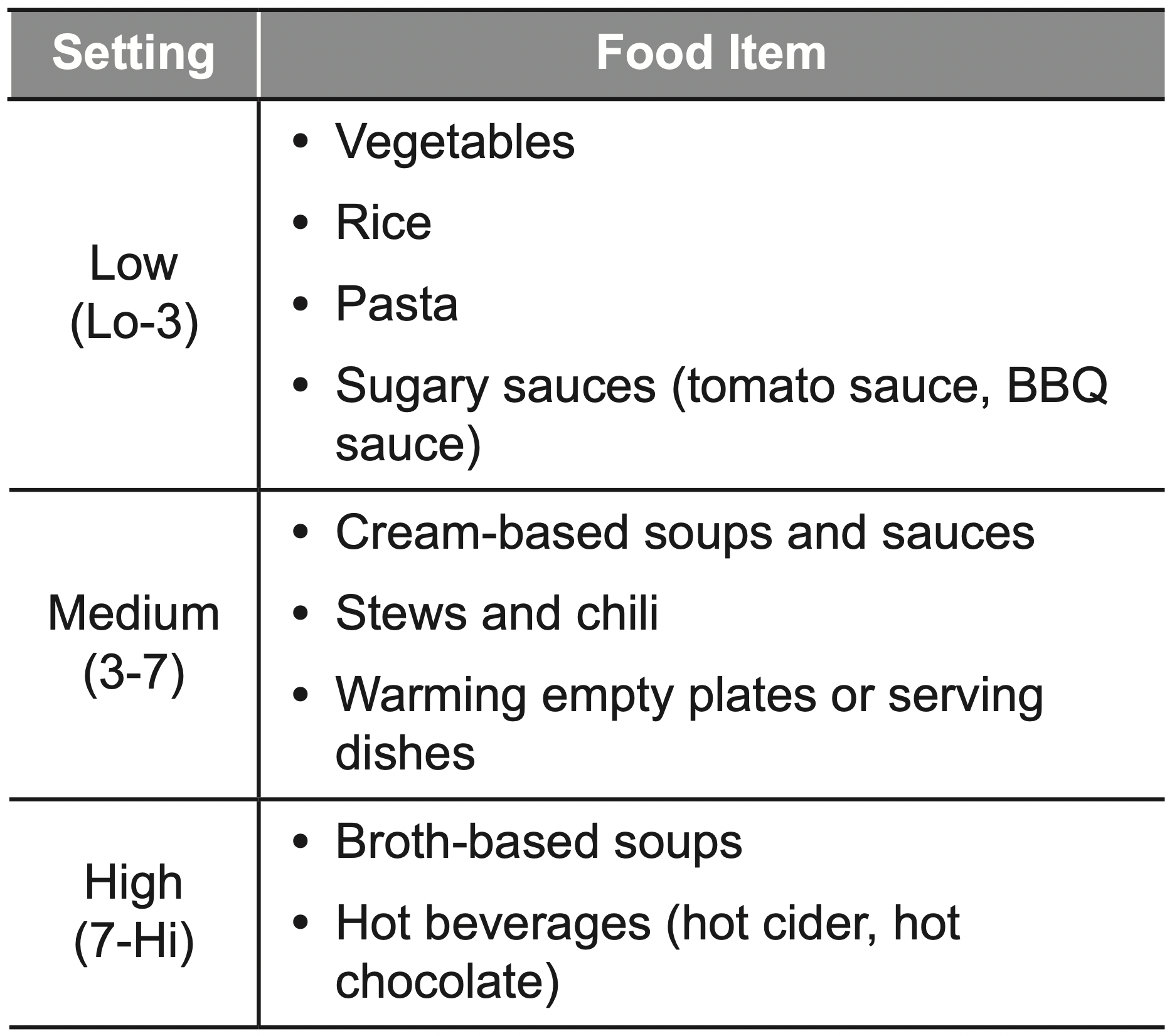
Using the Oven
Before Using the Oven
NOTE:
- Because the oven temperature cycles, an oven thermometer placed in the oven cavity may not show the same temperature that is set on the oven.
- It is normal for the convection fan to run while preheating during a regular bake cycle.
- The convection fan motor may run periodically during a regular bake cycle.
- The heat turns off if the door is left open during baking. If the door is left open for longer than 30 seconds during baking, the heat turns off. The heat turns back on automatically once the door is closed.
Oven Vent
Areas near the vent may become hot during operation and may cause burns. Do not block the vent opening. Avoid placing plastics near the vent as heat may distort or melt the plastic.
It is normal for steam to be visible when cooking foods with high moisture content.
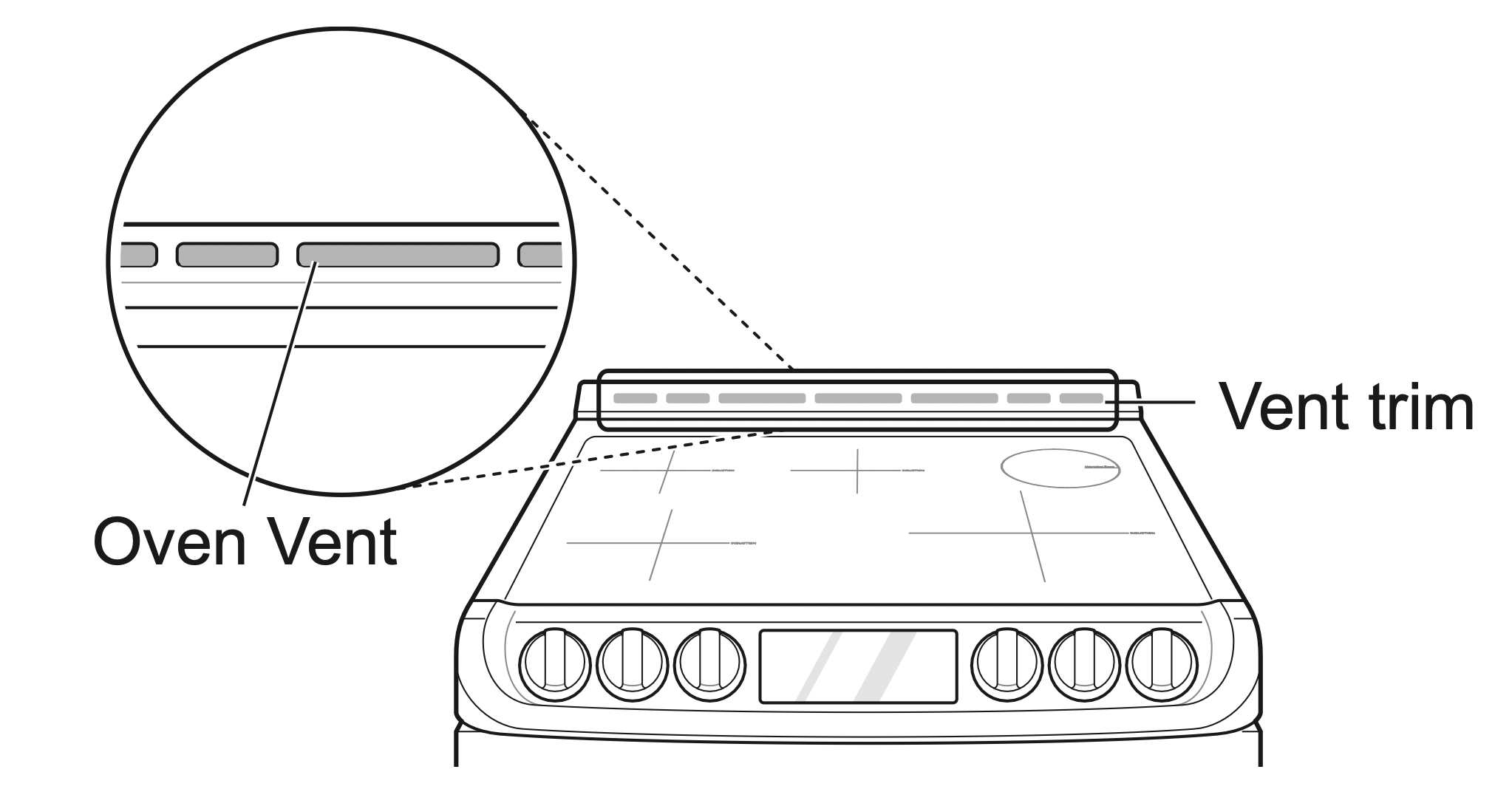
CAUTION: The edges of the range vent and vent trim are sharp and may become hot during operation. Wear gloves when cleaning the range to avoid burns or other injury.
Using Oven Racks
The racks have a turned-up back edge that prevents them from being pulled out of the oven cavity.
Removing Racks
- Pull the rack straight out until it stops.
- Lift up the front of the rack and pull it out.
Replacing Racks
- Place the end of the rack on the support.
- Tilt the front end up and push the rack in.
CAUTION
- Replace oven racks before turning the oven on to prevent burns.
- Do not cover the racks with aluminum foil, or any other material, or place anything on the bottom of the oven. Doing so will result in poor baking and may damage the oven bottom.
- Only arrange oven racks when the oven is cool.
Bake
Bake is used to prepare foods such as pastries, breads and casseroles. The oven can be programmed to bake at any temperature from 170 °F (80°C) to 550°F (285°C). The default temperature is 350°F (175°C).
Setting the Bake Function (example, 375°F)
- Turn the oven mode knob to select Bake.
- Set the oven temperature: for example, press plus (+) until 375°F appears in the display.
- Press Start. The oven starts to preheat.
As the oven preheats, the temperature is displayed and rises in 5 degree increments. Once the oven reaches the set temperature, a tone sounds and the oven light blinks on and off. - When cooking is complete, turn the oven mode knob to the Off position.
- Remove food from the oven.
NOTE: It is normal for the convection fan to operate periodically throughout a normal bake cycle in the oven. This is to ensure even baking results.
Baking Tips
- Baking time and temperature will vary depending on the characteristics, size, and shape of the baking pan used.
- Check for food doneness at the minimum recipe time.
- Use metal bakeware (with or without a nonstick finish), heatproof glass-ceramic, ceramic or other bakeware recommended for oven use.
- Dark metal pans or nonstick coatings will cook food faster with more browning. Insulated bakeware will slightly lengthen the cooking time for most foods.
NOTE: The oven bottom has a porcelain-enamel finish. To make cleaning easier, protect the oven bottom from exce ssive spillovers by placing a cookie sheet on the rack below the rack you are cooking on. This is particularly important when baking a fruit pie or other foods with a high acid content. Hot fruit fillings or other foods that are highly acidic may cause pitting and damage to the porcelain-enamel surface and should be wiped up immediately.
Convection Mode
The convection system uses a fan to circulate the heat evenly within the oven. Improved heat distribution allows for even cooking and excellent results while cooking with single or multiple racks.
Setting the Convection Function ( example, 375°F)
- Turn the oven mode knob to select the Conv. Bake or Conv. Roast.
- Set the oven temperature: for example, press plus (+) until 375°F appears in the display.
- Press Start. The display shows Conv. Bake or Conv. Roast and the oven temperature starting at 100°F.
As the oven preheats, the display shows increasing temperatures in 5-degree increments. Once the oven reaches the set adjusted temperature, a tone sounds and the oven light flashes on and off. The display shows the auto converted oven temperature, 350°F and the fan icon. - When cooking has finished or to cancel, turn the oven mode knob to the Off position.
NOTE: The oven fan runs while convection baking. The fan stops when the door is open. In some cases, the fan may shut off during a convection bake cycle.
Tips for Convection Baking
- Use Convection Bake for faster and more even multiple-rack cooking of pastries, cookies, muffins, biscuits, and breads of all kinds.
- Bake cookies and biscuits on pans with no sides or very low sides to allow heated air to circulate around the food. Food baked on pans with a dark finish will cook faster.
- If cooking on single rack, place the rack in the position suggested in the charts on the following pages. If cooking on multiple racks, place the oven racks in positions 3 and 5 (for two racks).
- Multiple oven rack cooking may slightly increase cook times for some foods.
- Cakes, cookies and muffins have better results when using multiple racks.
The Convection Roast feature is designed to give optimum roasting performance. Convection Roast combines cooking with the convection fan to roast meats and poultry. The heated air circulates around the food from all sides, sealing in juices and flavors. Foods are crispy brown on the outside while staying moist on the inside. Convection roasting is especially good for large tender cuts of meat, uncovered.
Tips for Convection Roasting
Use a broiler pan and grid when preparing meats for roasting. The broiler pan catches grease spills and the grid helps prevent grease splatters.
- Place the oven rack in the position suggested in the charts on the following pages.
- Place the grid in the broiler pan.
- Place the broiler pan on the oven rack.

Grid (sold separately)

Broiler pan (sold separately)
CAUTION:
- Do not use a broiler pan without a grid.
- Do not cover the grid with aluminum foil.
- Position food (fat side up) on the grid.
Recommended Baking and Roasting Guide
Baking results will be better if baking pans are centered in the oven as much as possible. If cooking on multiple racks, place the oven racks in the positions shown.
Rack and Pan Placement
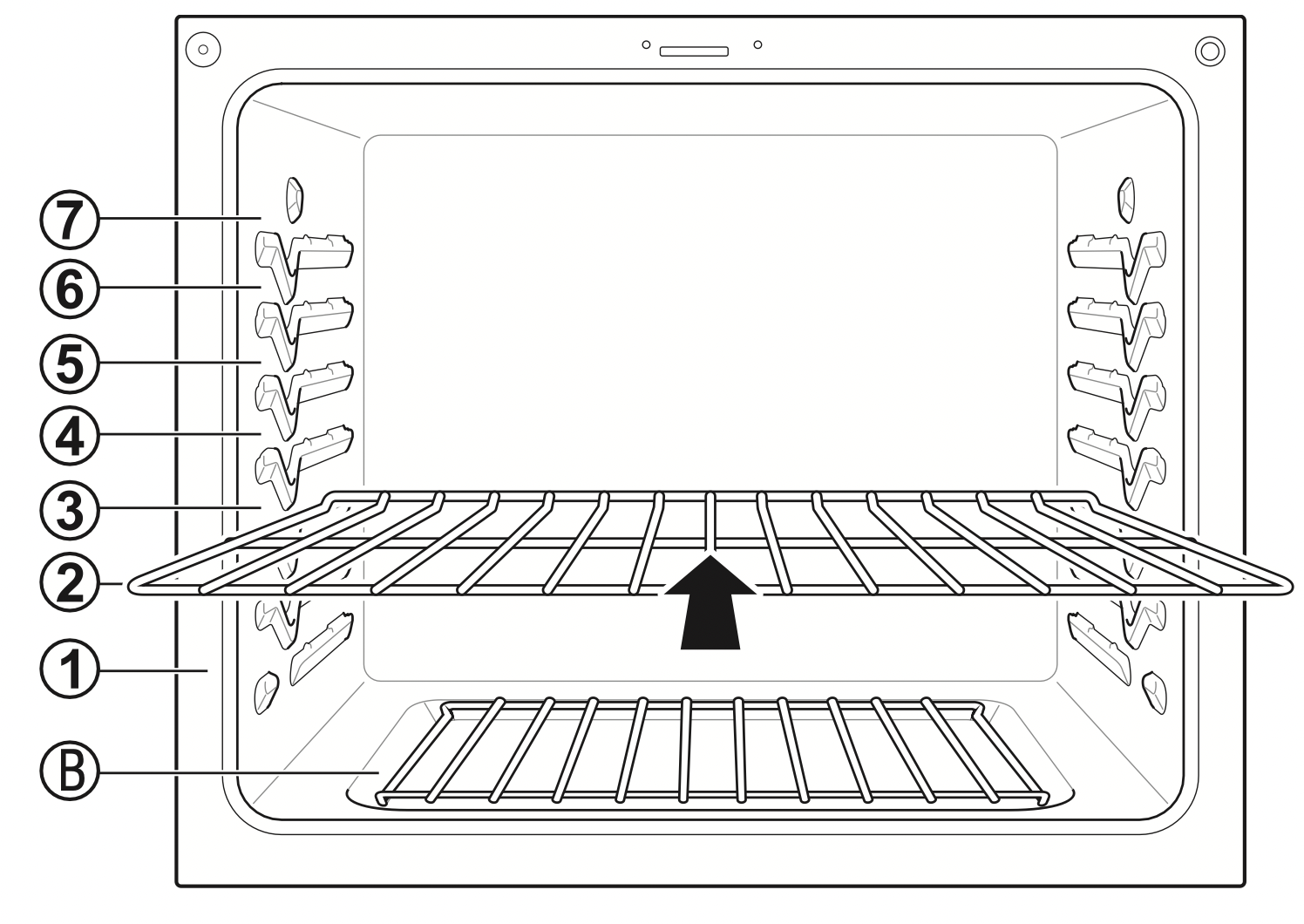
For Model: LSE4617
Single rack baking
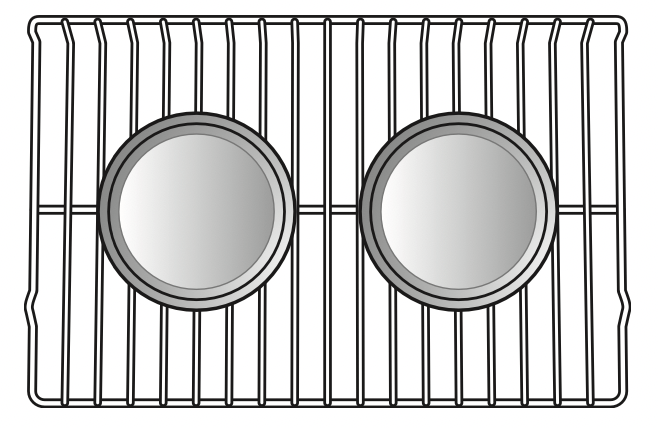
Rack
Multiple rack baking

Rack (Position 5)

Rack (Position 3)
Multiple rack roasting
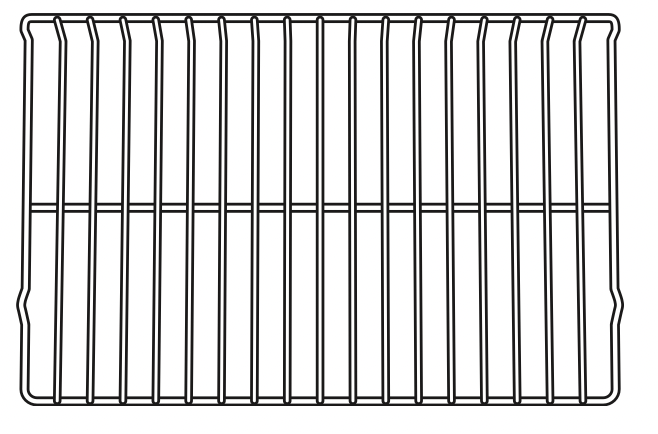
Rack (Position 4)
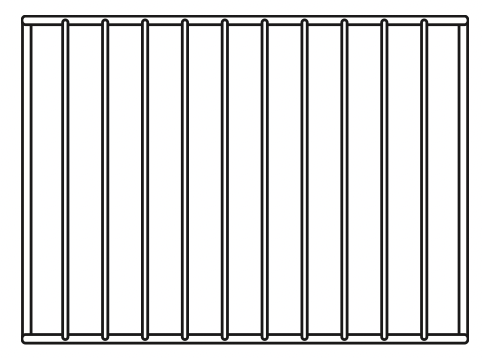
Bottom Rack (Position B)
- Multiple roasting helps to make more than 2 roasted foods at same time.
- If roasting on multiple racks, place more than 2 broiler pans and 2 grids on the racks.
For Model: LSE4616
Single rack baking

Rack
Multiple rack baking
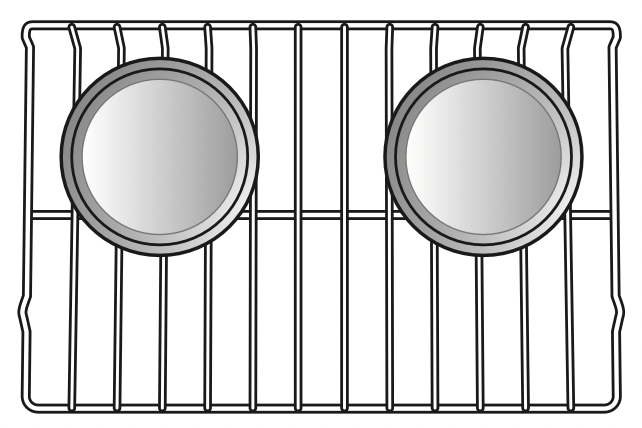
Rack (Position 3)

Rack (Position 5)
Baking rack guide
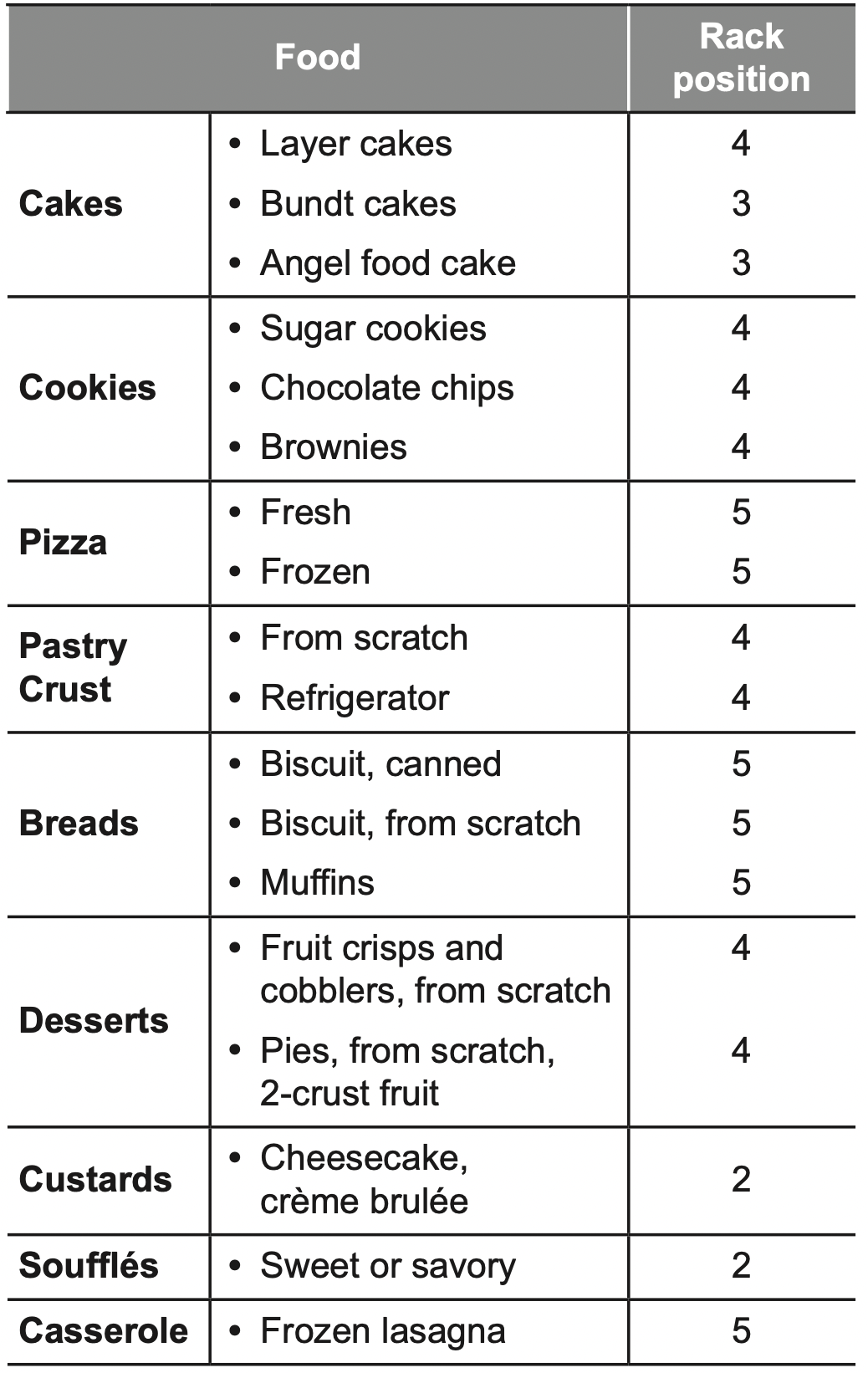
Roasting rack guide
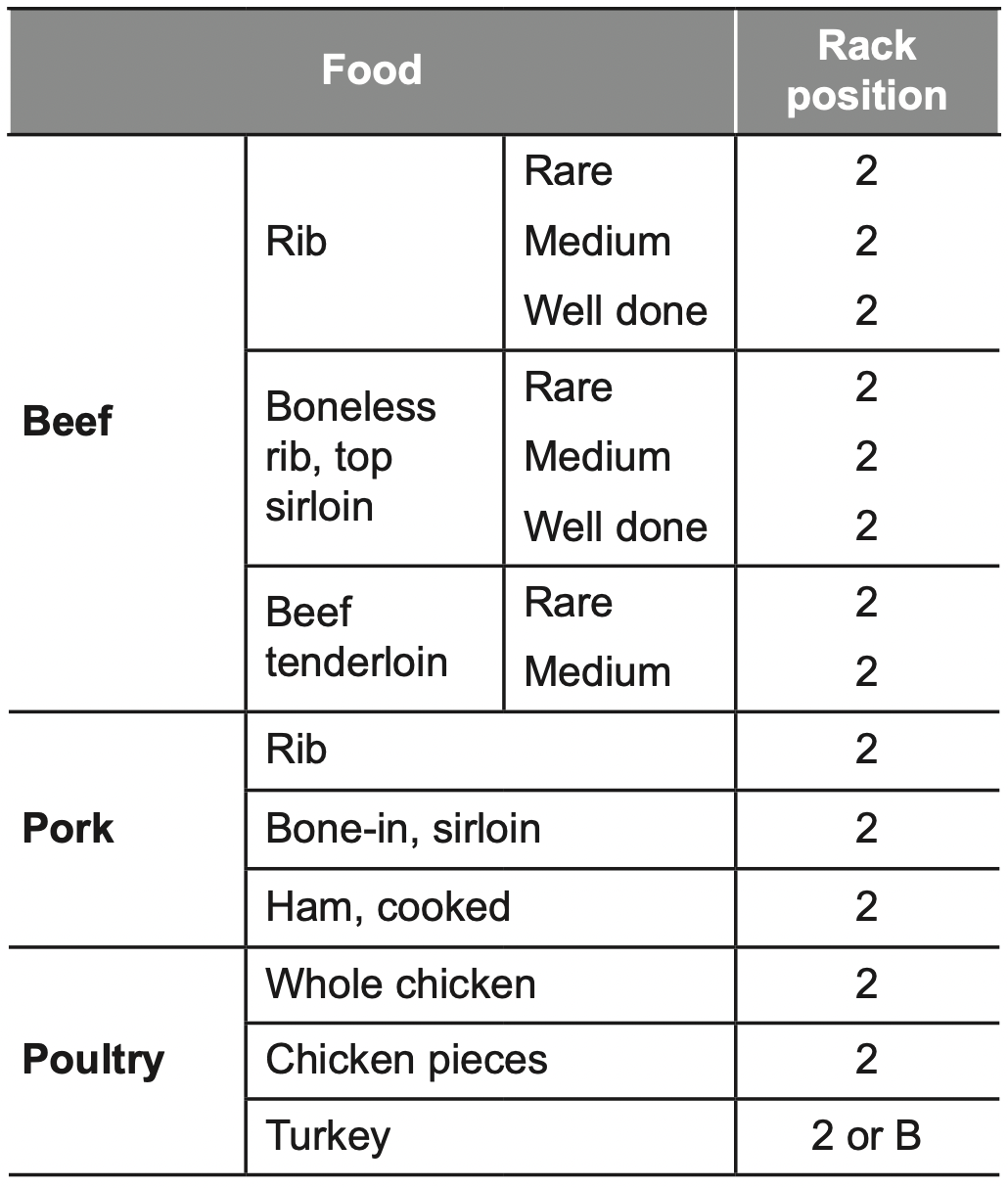
Broil
The Broil function uses intense heat from the upper heating element to cook food. Broiling works best for tender cuts of meat, fish, and thinly cut vegetables.
Some models may feature a hybrid broiler consisting of an inner broiler that utilizes a carbon heating element which provides instantaneous heat, and a traditional outer broiling element. During normal broiler operation, it is normal for either element to cycle off intermittently.
CAUTION:
- Do not use a broiler pan without a grid. Oil can cause a grease fire.
- Do not cover the grid and broiler pan with aluminum foil. Doing so will cause a fire.
- Always use a broiler pan and grid for exce ss fat and grease drainage. This will help to reduce splatter, smoke, and flare-ups.
NOTE: This range is designed for closed-door broiling. Close the door to set the Broil function. If the door is open, the Broil function cannot be set and door appears on the display. Close the door and reset the Broil function. Opening the door turns off the broil burner during broiling. If the door is opened during broiling, the broil burner turns off after five seconds. The broiler turns back on automatically once the door is closed.
Speed Broil ( For Model: LSE4617) The Speed Broil setting is designed to reduce the amount of time it takes to broil foods. By utilizing the infrared broil element, which provides heat instantaneously, there is no need for preheating.
Setting the oven to Broil / Speed Broil
- Turn the oven mode knob to select Broil Hi, Lo or Speed Broil. (LSE4617 model only)
- Press plus (+) or minus (-) to select Hi or Lo. (LSE4617 model only)
- Press Start. The oven begins to heat.
- Let the oven preheat for approxi mately five minutes before cooking the food if using broil.
- Turn the oven mode knob to the Off position to cancel at any time or when cooking is complete.
Smoking
Due to the intense heat associated with broiling, it is normal to experience smoke during the cooking process. This smoke is a natural by product of searing and should not cause you to worry. If you are experiencing more smoke than you are comfortable with, use the following tips to reduce the amount of smoke in your oven.
- Always use a broiler pan. Do not use saute pans or regular baking sheets for safety reasons.
- The broiler pan should always be thoroughly cleaned and at room temperature at the beginning of cooking.
- Always run your cooktop ventilation system or vent hood during broiling.
- Keep the interior of your oven as clean as possible. Leftover debris from prior meals can burn or catch fire.
- Avoid fatty marinades and sugary glazes. Both of these will increase the amount of smoke you experience. If you would like to use a glaze, apply it at the very end of cooking.
- If you are experiencing significant smoke with any food item, consider:
Lowering the broiler to the Lo setting.
Lowering the rack position to cook the food further away from the broiler.
Using the Hi broil setting to achieve the level of searing you desire, and then either switching to the Lo broil setting, or switching to the Bake function. - As a rule, fattier cuts of meat and fish will produce more smoke than leaner items.
- Adhere to the recommended broil settings and cooking guidelines in the chart on the following page whenever possible.
Recommended Broiling Guide
The size, weight, thickness, starting temperature, and your preference of doneness will affect broiling times. This guide is based on meats at refrigerator temperature. For best results when broiling, use a pan designed for broiling.

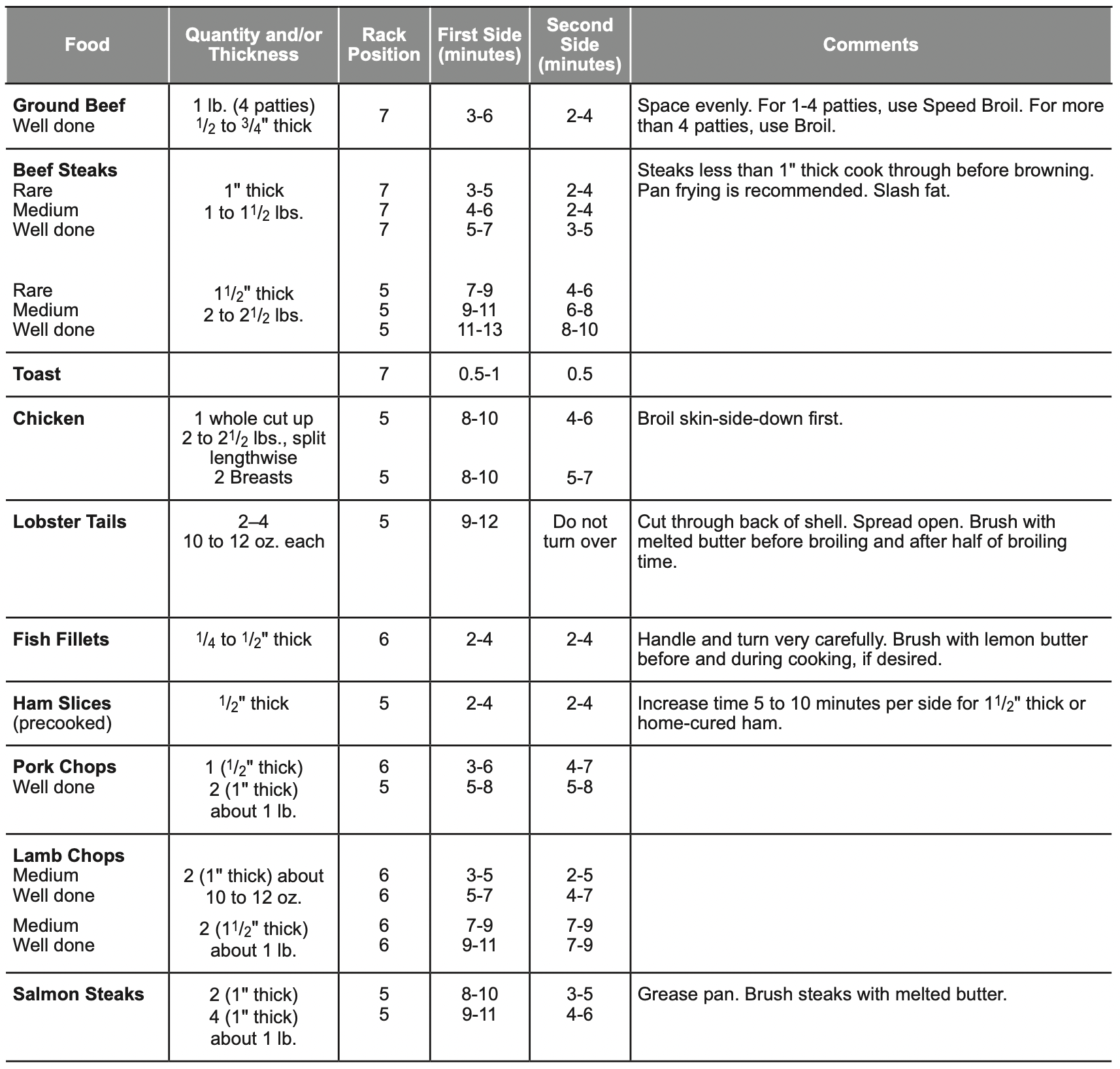
Tips for Broiling Beef
- Steaks and chops should always be allowed to rest for five minutes before being cut into and eaten.
This allows the heat to distribute evenly through the food and creates a more tender and juicy result. - Pieces of meat that are thicker than two inches should be removed from the refrigerator 30 minutes prior to cooking. This will help them cook more quickly and evenly, and will produce less smoke when broiling. Cooking times will likely be shorter than the times indicated in the Broiling Chart.
- For bone-in steaks or chops that have been frenched (all meat removed from around the bone), wrap the exposed sections of bone in foil to reduce burning.
Seafood
- When broiling skin-on fish, always use the Lo broil setting and always broil the skin side last.
- Seafood is best consumed immediately after cooking. Allowing seafood to rest after cooking can cause the food to dry out.
- It is a good idea to rub a thin coating of oil on the surface of the broiling pan before cooking to reduce sticking, especially with fish and seafood. You can also use a light coating of non-stick pan spray.
Vegetables
- Toss your vegetables lightly in oil before cooking to improve browning.
Warm
This function will maintain an oven temperature of 170°F. The Warm function will keep cooked food warm for serving up to three hours after cooking has finished. The Warm function may be used without any other cooking operations.
Setting the Warm Function
- Turn the oven mode knob to select Warm.
- Press Start.
- Turn the oven mode knob to the Off position when warming is finished.
NOTE:
- The Warm function is intended to keep food warm. Do not use it to cool food down.
- It is normal for the fan to operate during the Warm function.
Proof
This feature maintains a warm oven for rising yeast leavened products before baking.
Setting the Proof Function
- Use rack position 2 or 3 for proofing.
- Turn the oven mode knob to select Proof.
- Press Start.
- Turn the oven mode knob to the Off position when proofing is finished.
NOTE:
- To avoid lowering the oven temperature and lengthening proofing time, do not open the oven door unnecessarily. Check bread products early to avoid over proofing.
- Do not use the proofing mode for warming food or keeping food hot. The proofing oven temperature is not hot enough to keep foods at safe temperatures. Use the Warm feature to keep food warm. Proofing does not operate when the oven is above 125°F. Hot shows in the display.
- It is normal for the fan to operate during the Proof function.
Speed Roast
The Speed Roast feature is designed to quickly roast poultry. The combination of intense heat from the upper heating element and heated air from the back heating element result in crispier food and help to save cooking time. Speed roasting is especially good for medium sized poultry.
NOTE:
- The recommended cook time is 60-65 minutes for a whole chicken weighing 3.3 lb.
- Adjust the cook time according to the weight of the poultry.
- Place the oven rack in position 2.
- Speed Roast is designed to reduce the cooking time. There is no need for preheating.
- This function is optimized for poultry, so the temperature of Speed Roast cannot be changed.
- It is normal for the fan to operate during the Speed Roast function.
Setting the Speed Roast Function
- Put food in the oven.
- Turn the oven mode knob to select Speed Roast. The display shows Roast Speed.
- Press Start.
Meat Probe (For model: LSE4617)
The meat probe accurately measures the internal temperature of meat, poultry and casseroles. It should not be used during broiling, self clean, warming or proofing. Always unplug and remove the meat probe from the oven when removing food. Before using, insert the probe into the center of the thickest part of the meat or into the inner thigh or breast of poultry, away from fat or bones. Place food in the oven and connect the meat probe to the jack. Keep the probe as far away from heat sources as possible.
Setting the Meat Probe Function (example for Roast 375°F with Probe temp. 160 °F)
- Insert the meat probe into the meat.
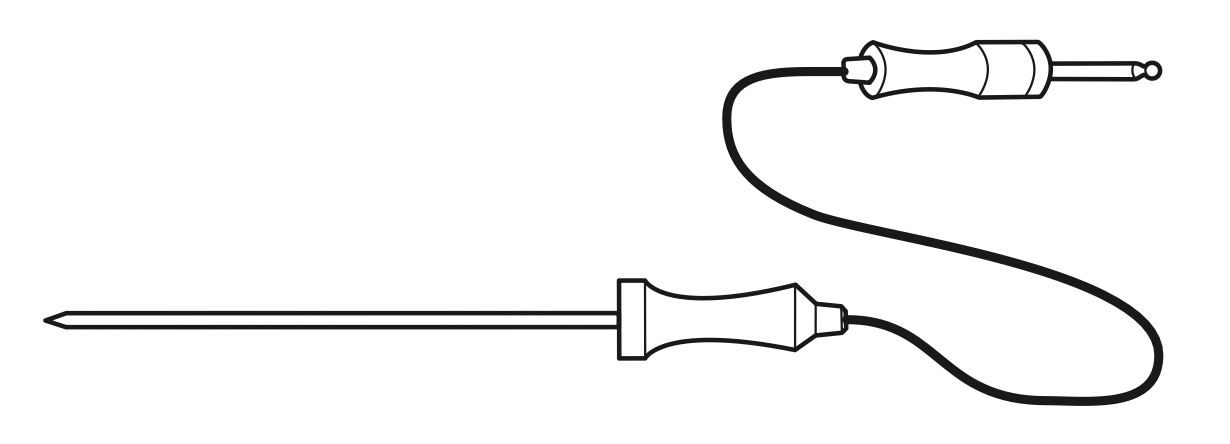
- Connect the meat probe to the jack.
- The meat probe icon flashes in the display if the meat probe is properly connected.
Setting the Probe Temperature
- Select cook mode. Turn the oven mode knob to select Conv. Roast.
- Set the oven temperature: press plus (+) or minus (-) until 375 °F appears in the display .
- Press Probe.
- Set the probe temperature: press plus (+) or minus (-) until 160 °F appears in the display .
- Press Start.
The default probe temperature is 150°F (65°C), but can be changed to any temperature between 80°F (27°C) and 210°F (100°C). The display shows the changing probe temperature. When the set probe temperature is reached, the oven shuts off automatically.
Changing the Probe temperature while cooking
- Press Probe.
- Set the probe temperature.
- Press Start.
IMPORTANT NOTE:
Turn the oven mode knob to the Off position to cancel the Meat Probe function at any time. To avoid breaking the probe, make sure food is completely defrosted before inserting.
CAUTION:
- Always use an oven mitt to remove the temperature probe. Do not touch the broil element. Failure to obey this caution can result in severe personal injury.
- To avoid damage to the meat probe, do not use tongs to pull on the probe when removing it.
- Do not store the meat probe in the oven.
- Do not pull wire to remove probe. Hold th e probe head, not the wire, when inserting or removing probe.

Recommended Probe Temperature Chart
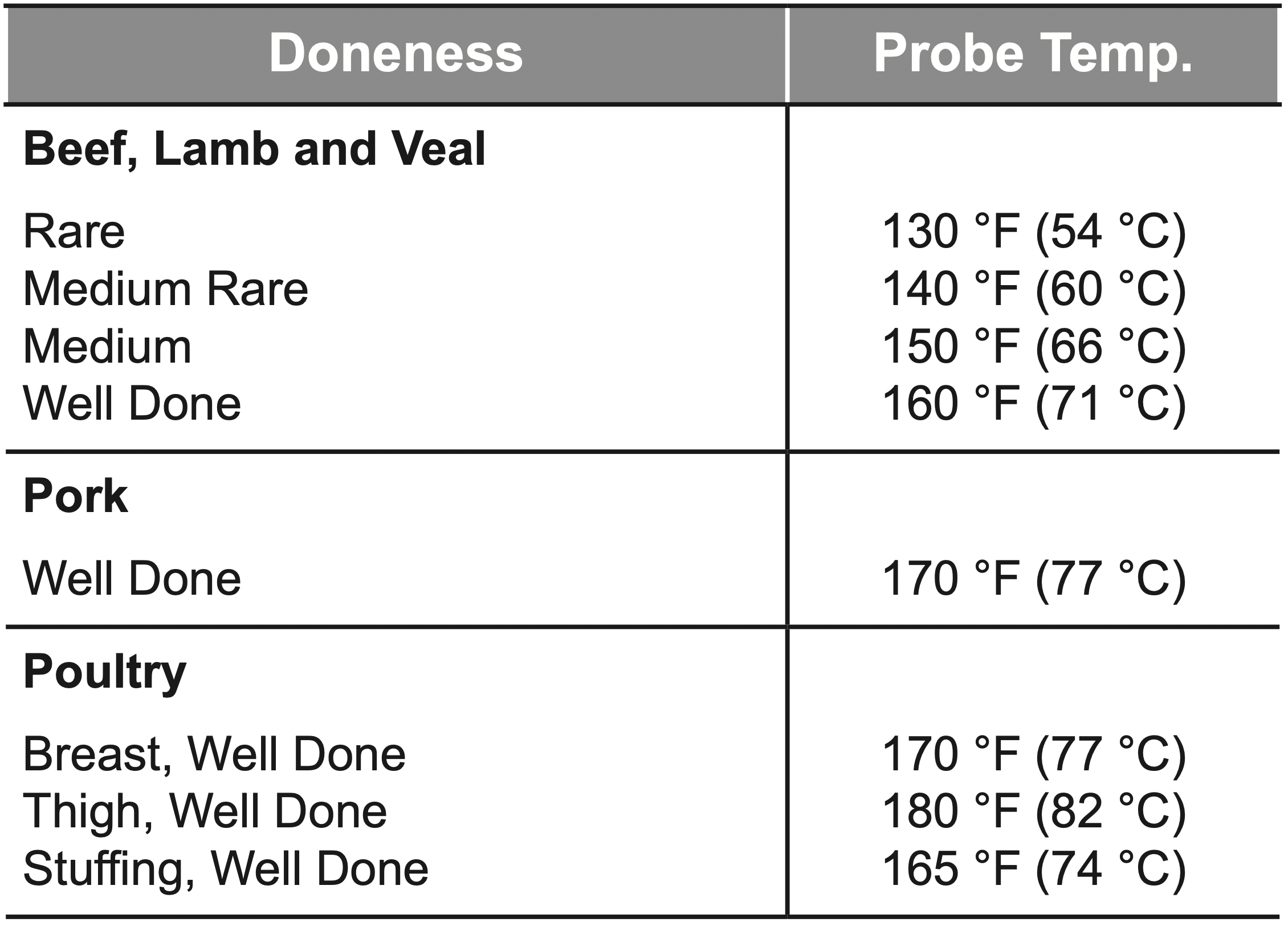
Remote Start
If the appliance is registered on a home Wi-Fi network, this function starts or stops the pre-heating function of the appliance. Follow the instructions on page 43 to register the appliance on the network.
Set the oven mode knob to the Remote Start position to use the function.
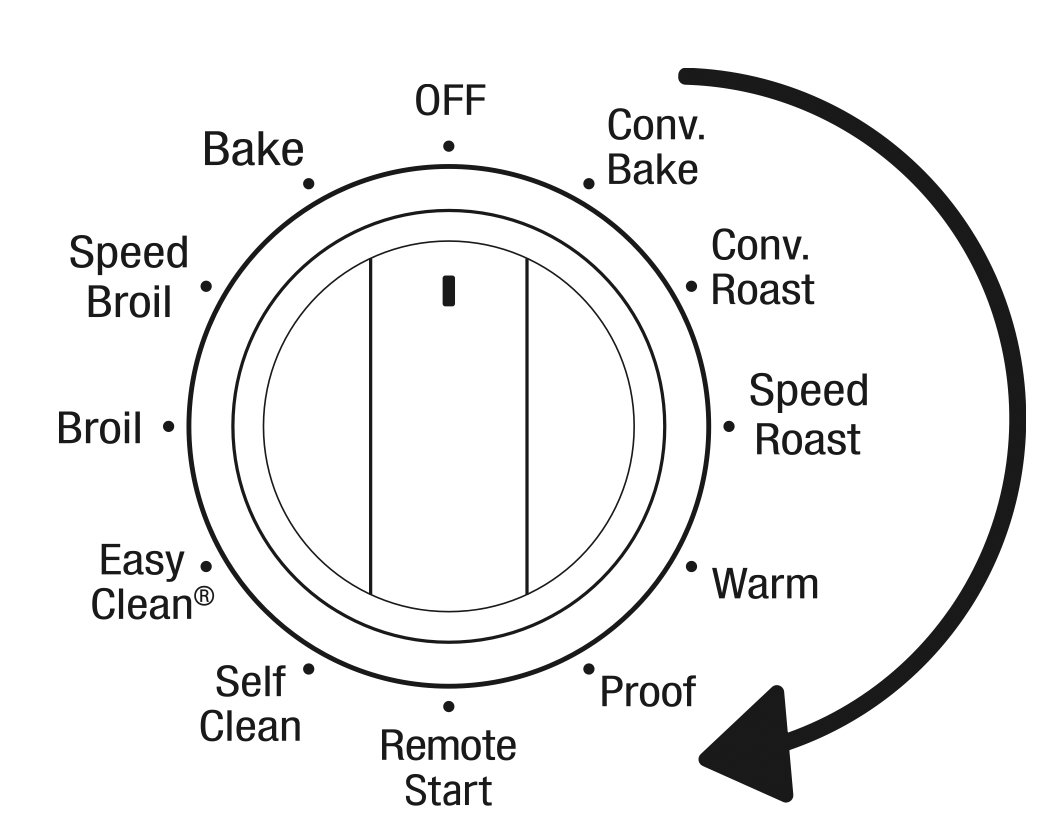
For Model: LSE4617
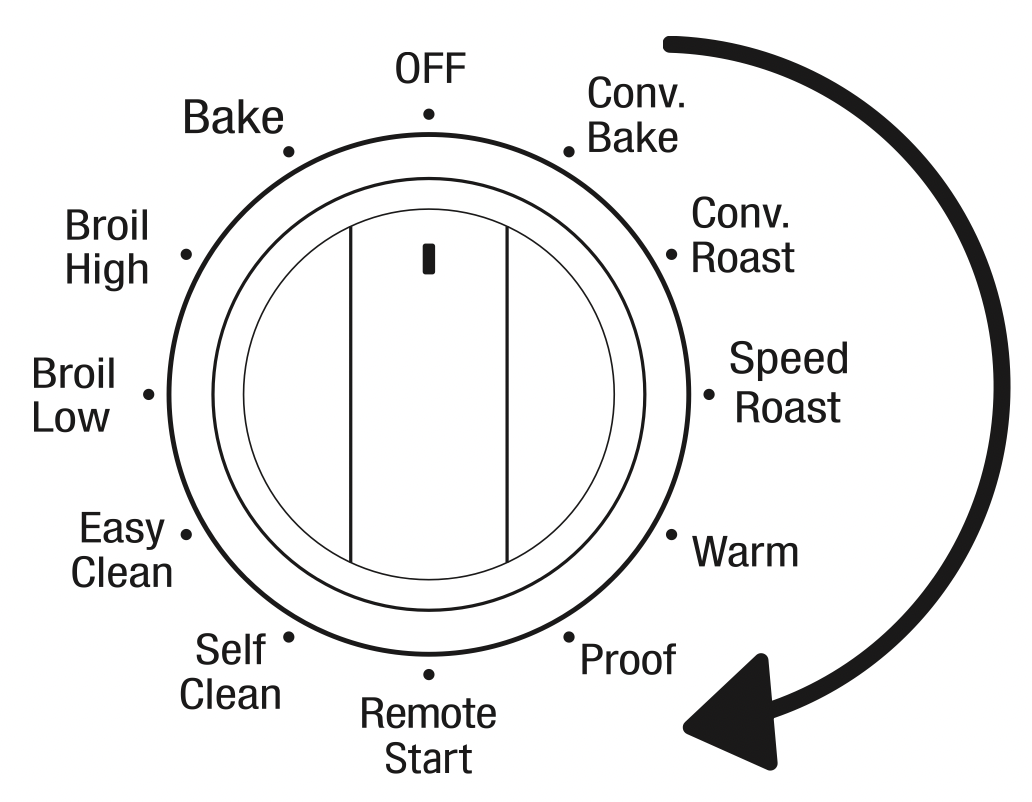
For Model: LSE4616
Setting Remote Start
- Open the oven door to make sure the oven is empty and ready for pre-heating. Do not place food in the oven. Close the oven door.
- Within 30 seconds of closing the door, turn the oven mode knob to select Remote Start. If more than 30 seconds passes before you initiate Remote Start, “door” appears in the display. If this occurs, open and close the door and try again.
- When ON appears in the display, the Remote Start function is ready to use.
- Follow the directions in the smart phone application to set the cook mode, temperature, and run time (preheating time plus holding time).
NOTE:
- Do not place food in oven before or during Remote Start run time.
- Remote Start is disconnected in the following situations:
- Remote Start is never set up in the smart phone app.
- The Remote Start status is “OFF” or “door” .
- Remote Start experiences a problem during operation.
- The Remote Start function cannot be started when the oven door is open. A beep alerts you to shut the door.
Operating the Warming Drawer (For model: LSE4617)
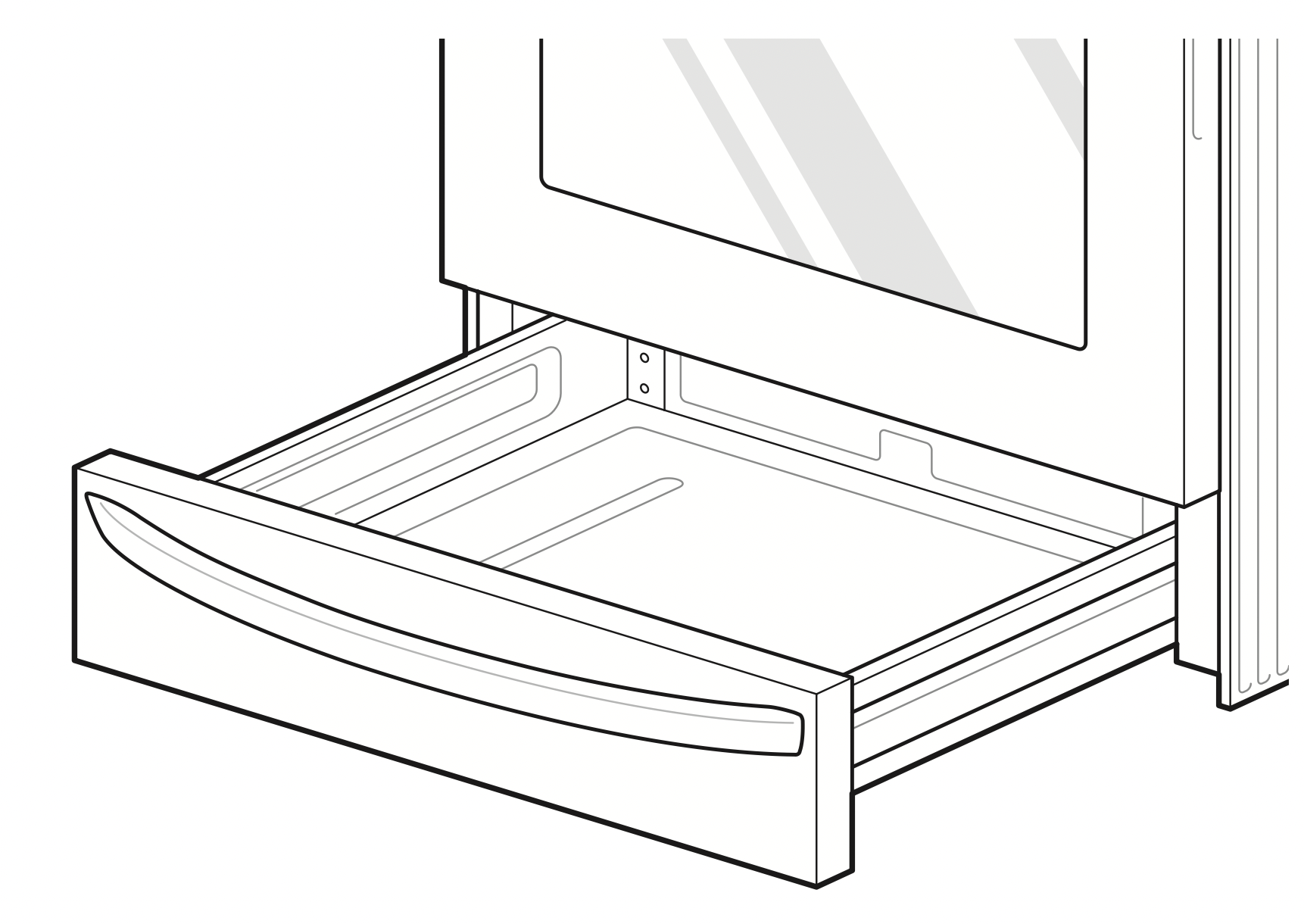
The Warming Drawer keeps hot cooked foods at serving temperature.
All food placed in the Warming Drawer should be covered with an oven-safe lid or aluminum foil to maintain quality. Do not place foil on bottom or sides of drawer. Do not use plastic wrap to cover food. Plastic may melt onto the drawer and be very difficult to clean. Use only utensils and cookware recommended for oven use in the Warming Drawer.
Setting the Warming Drawer Control
- Press Warming Drawer Set/Off. The indicator light will flash. (If no further buttons are pressed within 25 seconds, the display will clear.)
- Use the plus (+) or minus (-) button to set the power level:
 for Low,
for Low,  for Medium, and
for Medium, and  for High.
for High. - When the food is ready, or to cancel, press Warming Drawer Set/Off.
NOTE:
- The Warming Drawer shuts off automatically after three hours.
- Do not heat cold food in the Warming Drawer.
- Do not use pans or utensils with rough finishes in the Warming Drawer. Doing so can leave scratches on the inner drawer surfaces.
Warming Drawer food/power level recommendations

* Do not warm heat-sensitive foods for longer than 20 minutes.
Do not put thin cuts of meat in the warming drawer as they will dry out.
Different types of food may be placed in the warming drawer at the same time. For best results, do not leave food in the warming drawer for more than one hour. Do not leave smaller quantities or heat-sensitive food, such as eggs, in the warming drawer more than 30 minutes. The maxi mum operating time is three hours.
CAUTION:
- Do not use the warming drawer for storage of racks, broiler pans, insert pans, plates, or utensils. The warming drawer contains a heating element which may damage any items not specifically designed to be used with it and should only be used to store cookware specifically supplied by LG with your range.
- Do not put food or foil directly on the surface or base of the warming drawer. This may result in damage to your drawer and may spoil your food.
- Do not place plastic wrap in the warming drawer or use it to cover food being heated in the warming drawer. Plastic may melt onto the drawer or surrounding areas and is very difficult to remove. Use only aluminum foil or cookware that is capable of withstanding baking temperature to heat or cover your food.
- Do not use the warming drawer to heat water or any other liq uids. Spilled liq uids may cause an electrical short or result in severe personal injury, electric shock or death.
- Never place plastics, paper, canned foods or other combustible material into the warming drawer. These items pose a severe risk of fire, damage and injury.
- In the unlikely event that an item falls behind the warming drawer, always turn the power off and wait for the warming drawer to cool before retrieving the item. Never attempt to retrieve any items that fall behind the warming drawer without first turning the power off and ensuring the warming drawer cavity has cooled off. Failure to do so may result in severe personal injury, electric shock or death.
- Do not touch the surface of the warming drawer while it is in operation. Use oven mitts or hot pads when inserting or removing food to avoid burns or other inj ury.
- Do not leave food in the warming drawer for longer than one hour. Eating food which has been heated for too long at low temperatures can lead to food-borne illnesses.
MAINTENANCE
Cleaning the Glass-Ceramic Cooktop
CAUTION:
- Do not use scrub pads or abrasive cleaning pads. They may damage your cooktop surface.
- For your safety, wear an oven mitt or pot holder while using a scraper on the hot cooking surface.
- Read and follow all instructions and warnings on the cleaning cream label.
Use ceramic cooktop cleaner on the glass cooktop. Other creams may not be as effective or may scratch, damage or stain the cooktop surface.
- To maintain and protect the surface of the glass cooktop, follow these steps:
- Before using the cooktop for the first time, clean it with a ceramic cooktop cleaner. This helps protect the top and makes cleanup easier.
- Use ceramic cooktop cleaner daily to help keep the cooktop looking new.
- Shake the cleaning cream well. Apply a few drops of cleaner directly to the cooktop.
- Use a paper towel to clean the entire cooktop surface.
- Rinse with clear water and use a dry cloth or paper towel to remove all cleaning residue.
NOTE: Do not heat the cooktop until it has been cleaned thoroughly.
IMPORTANT: If any sugar or food containing sugar (preserves, ketchup, tomato sauce, jellies, fudge, candy, syrups, chocolate) spills, or plastic or foil melts on the cooktop, remove the molten material IMMEDIATELY with a metal razor scraper (it will not damage the decorated cooking surface) while the cooking surface is still hot to avoid the risk of damage to the glass-ceramic surface. For your safety, please use an oven mitt or pot holder while scraping the hot cooking surface.
Burned-On Residue
- While the cooktop is still hot, remove any burnt on deposits or spilled food from the glass-ceramic cooking surface with a suitable metal razor scraper. (Similar to scraping paint off of a windowpane, it will not damage the decorated cooking surface). Hold the scraper at an approxi mate 30° angle to the cooktop.
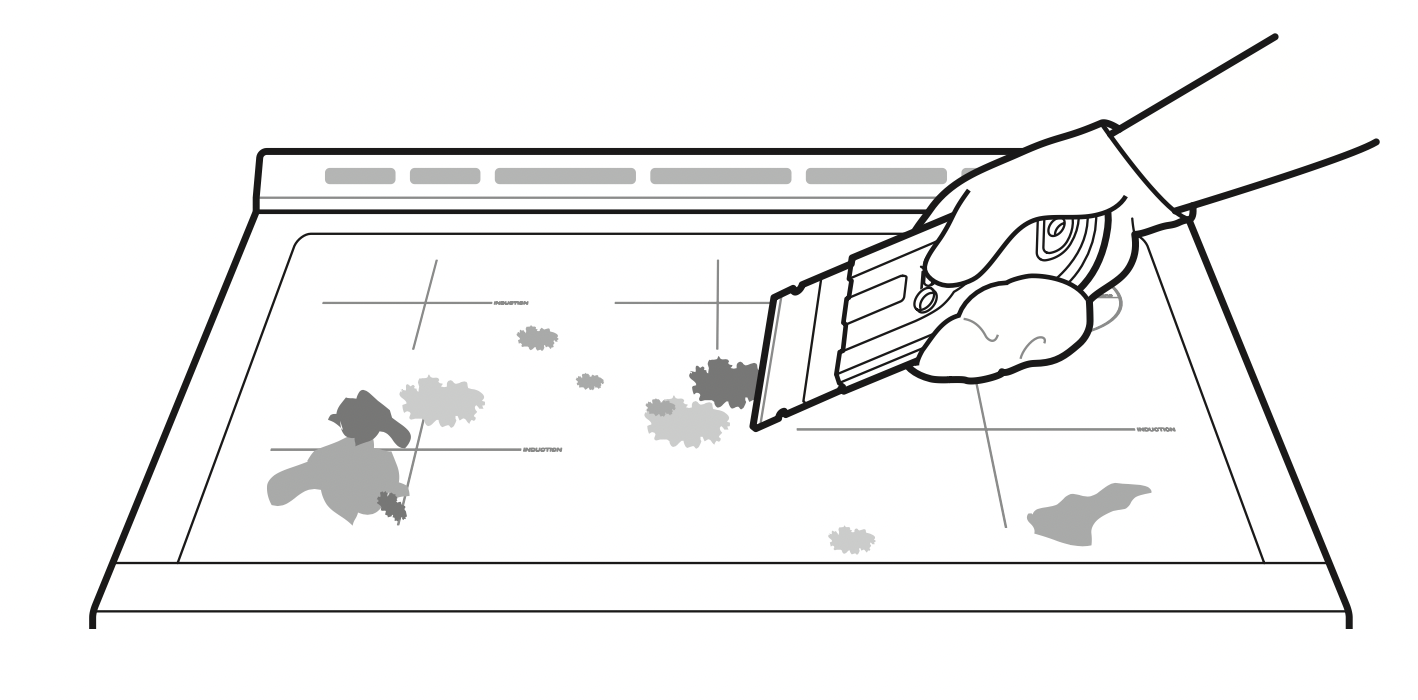
NOTE:
Do not use a dull or nicked blade.
To prevent burns, wear an oven mitt or pot holder while using the metal scraper. - When the cooking surface has cooled down, apply a few dabs (about the size of a dime) of an approved cleaner in each burner area and work the cleaning cream over the cooktop surface with a damp paper towel.

- Rinse with clean water and wipe the cooktop surface with a clean, dry paper towel.
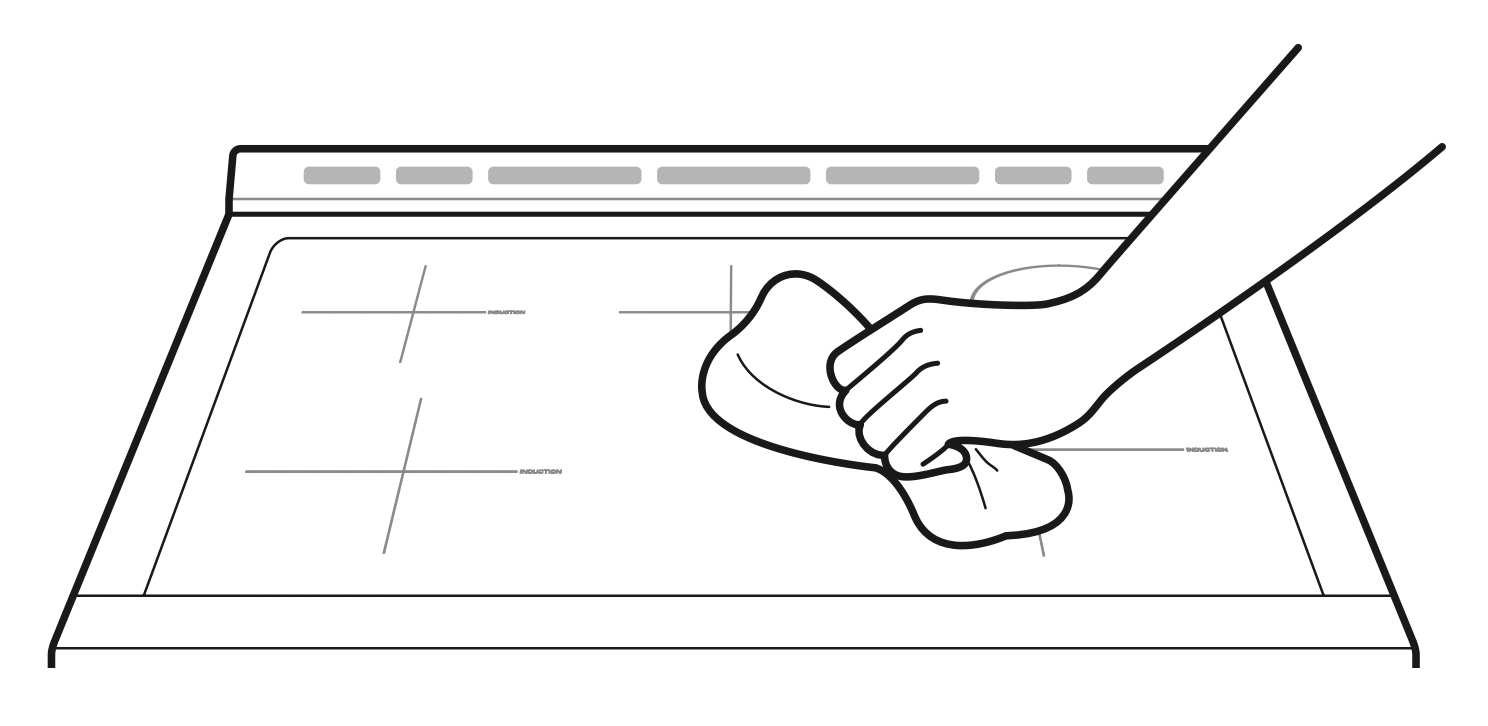
Metal Marks and Scratches
- Be careful not to slide pots and pans across the cooktop. Doing so will leave metal markings on the cooktop surface.
- To help remove these marks, use a ceramic cooktop cleaner with a cleaning pad for ceramic cooktops.
CAUTION: Cookware with rough or uneven bottoms can mark or scratch the cooktop surface.
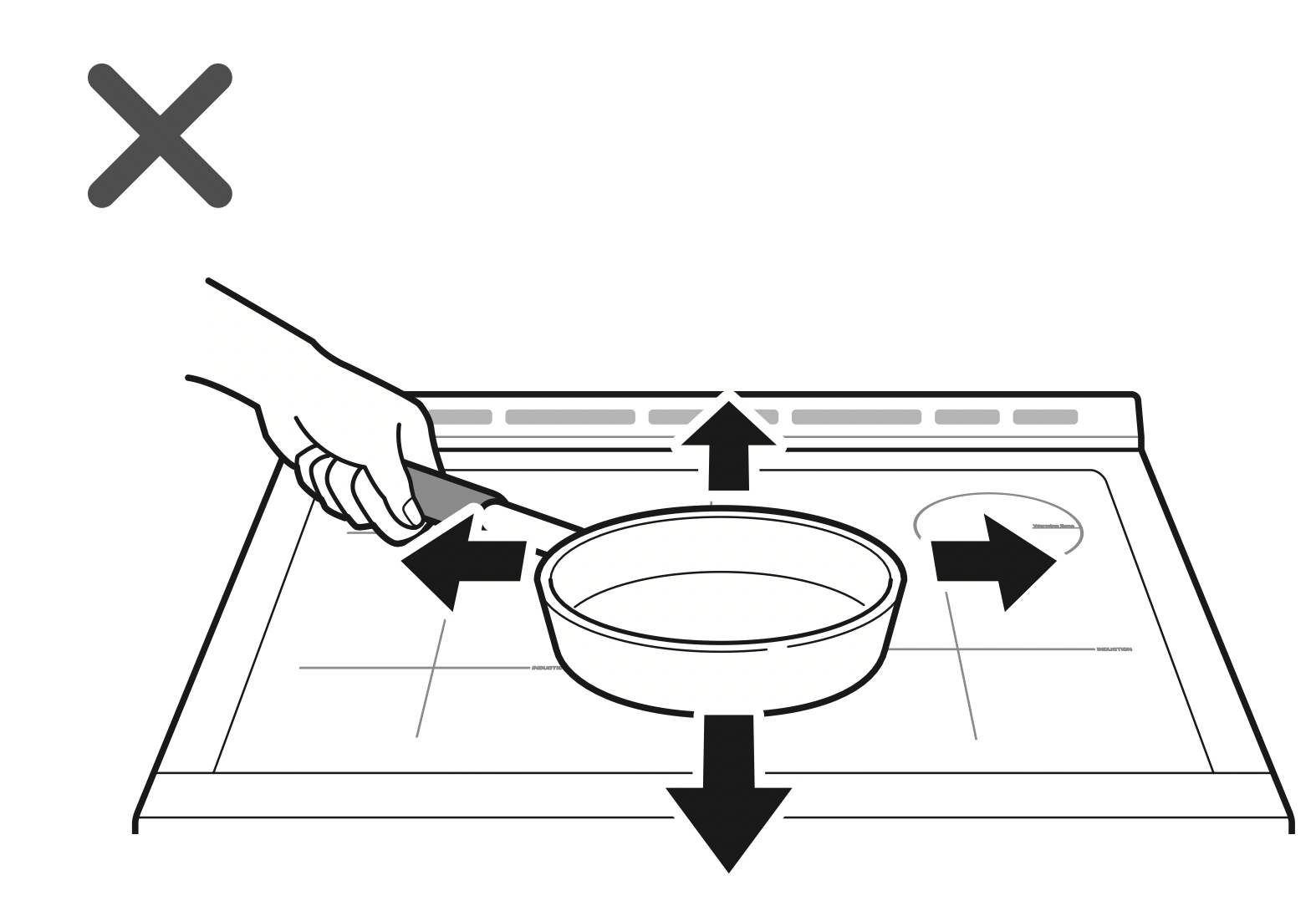
- Do not slide metal or glass across the cooktop surface.
- Do not use cookware with any dirt build-up on the bottom.
EasyClean®
LG’s EasyClean® enamel technology provides two cleaning options for the inside of the range. The EasyClean® feature takes advantage of LG’s new enamel to help lift soils without harsh chemicals, and it runs using ONLY WATER for just 20 minutes (10 minutes for LRG3194) in low temperatures to help loosen LIGHT soils before hand-cleaning.
While EasyClean® is quick and effective for small and LIGHT soils, the Self Clean feature can be used to remove HEAVY, built up soils. The intensity and high heat of the Self Clean cycle may result in smoke which will require the opening up of windows to provide ventilation. Compared to the more intense Self Clean process, your LG oven gives you the option of cleaning with LESS HEAT, LESS TIME, and virtually NO SMOKE OR FUMES.
Benefits of EasyClean®
- Helps loosen light soils before hand-cleaning
- EasyClean® only uses water; no chemical cleaners
- Makes for a better self-clean experience
- Delays the need for a self-clean cycle
- Minimizes smoke and odors
- Can allow shorter self-clean time
NOTE: Some models do not include a self-clean option. The EasyClean® feature may not be effective in removing heavy, built-up soils. If the range does not include a self-clean option, clean the oven regularly using the EasyClean® feature to prevent heavy, burnt-on soil from building up in the oven.
When to Use EasyClean®
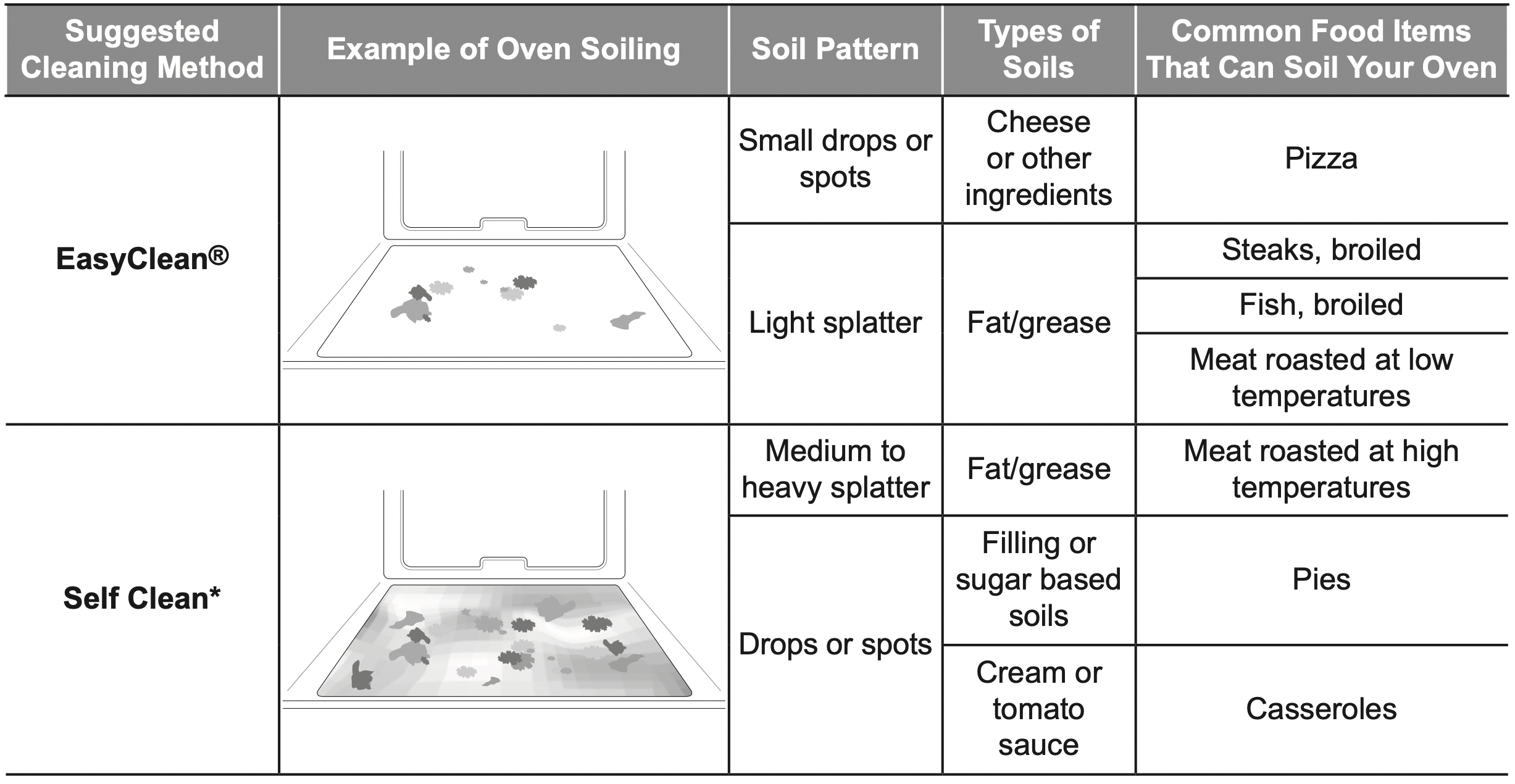
* The Self Clean cycle can be used for soil that has been built up over time.
EasyClean® Instruction Guide
- Remove oven racks and accessories from the oven.
- Scrape off and remove any burnt-on debris with a plastic scraper.

Suggested plastic scrapers:
Hard plastic spatula
Plastic pan scraper
Plastic paint scraper
Old credit card - Fill a spray bottle (10 oz or 300 ml) with water and use the spray bottle to thoroughly spray the inside surfaces of the oven.
- Use at least 1/5 (2 oz or 60 ml) of the water in the bottle to completely saturate the soil on both the walls and in the corners of the oven.
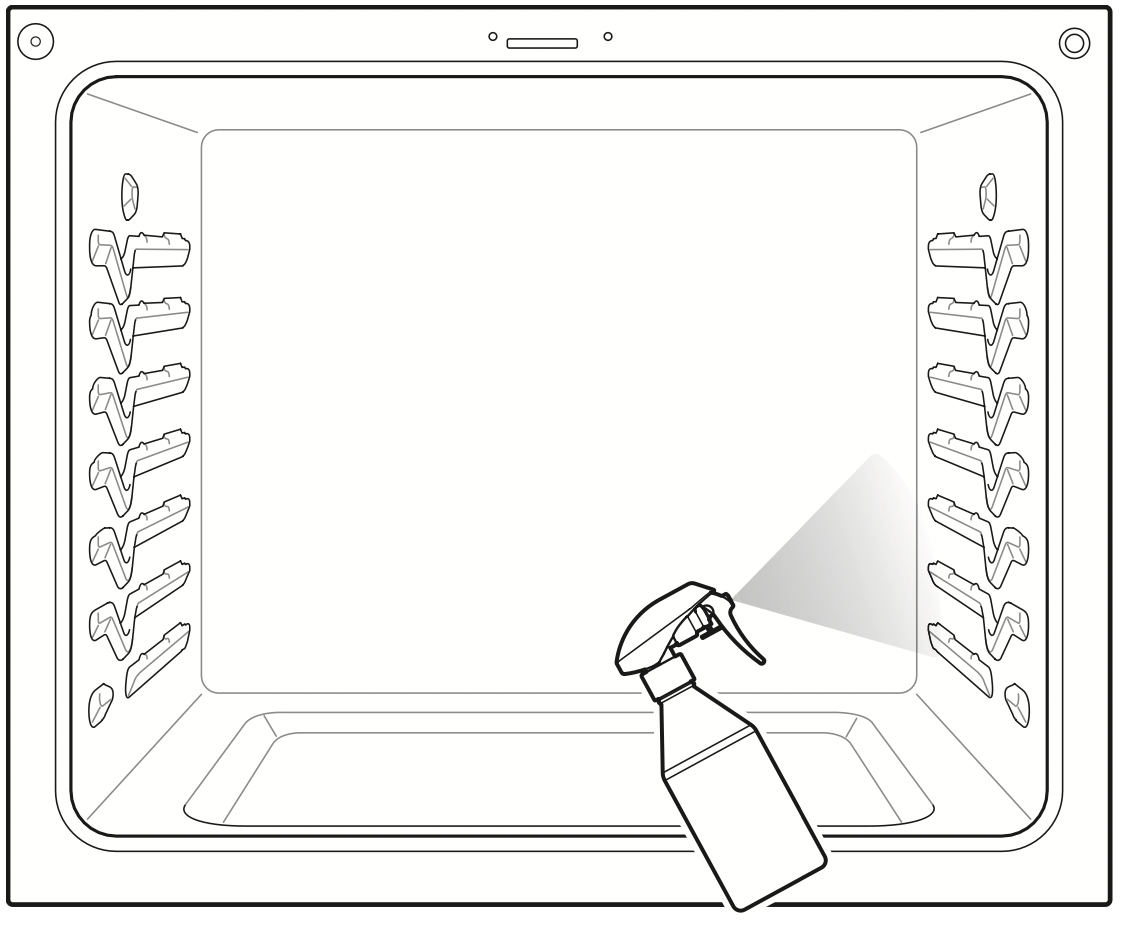
- Spray or pour the remaining water (8 oz or 240 ml) onto the bottom center of the oven cavity. The indentation on the oven bottom should be fully covered to submerge all soils. Add water if necessary.
NOTE: If cleaning multiple ovens, use an entire bottle of water to clean each oven. D o not spray water directly on the door. D oing so will result in water dripping to the floor. - Close the oven door.
Turn the oven mode knob to select EasyClean®.
Press Start.
CAUTION
Some surfaces may be hot after the EasyClean® cycle. Wear rubber gloves while cleaning to prevent burns.
During the EasyClean® cycle, the oven becomes hot enough to cause burns. Wait until the cycle is over before wiping the inside surface of the oven. Failure to do so may result in burns.
Avoid leaning or resting on the oven door glass while cleaning the oven cavity. - A tone will sound at the end of the 10 minute cycle. Turn the oven mode knob to the Off position to clear the display and end the tone.
- After the cleaning cycle and during handcleaning, enough water should remain on the oven bottom to completely submerge all soils. Add water if necessary. Place a towel on the floor in front of the oven to capture any water that may spill out during hand-cleaning.
- Clean the oven cavity immediately after the EasyClean® cycle by scrubbing with a wet, non-scratch scouring sponge or pad. (The scouring side will not scratch the finish.) Some water may spill into the bottom vents while cleaning, but it will be captured in a pan under the oven cavity and will not hurt the burner.
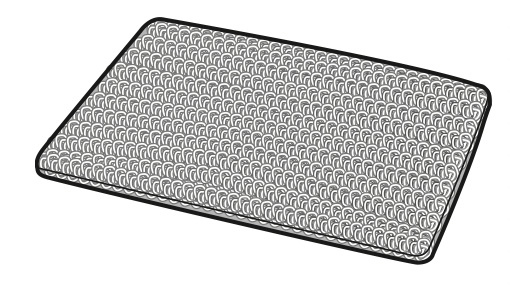
NOTE: Do not use any steel scouring pads, abrasive pads or cleaners as these materials can permanently damage the oven surface. - Once the oven cavity is cleaned, wipe any excess water with a clean dry towel. Replace racks and any other accessories.
- If some light soils remain, repeat the above steps, making sure to thoroughly soak the soiled areas. If stubborn soils remain after multiple EasyClean® cycles, run the Self Clean cycle. Be sure that the oven cavity is empty of oven racks and other accessories, and that the oven cavity surface is dry before running the Self Clean cycle. Consult the Self Clean section of your owner’s manual for further details.
NOTE
- If you forget to saturate the inside of the oven with water before starting EasyClean® , turn the Oven mode knob to the Off position to end the cycle. Wait for the range to cool to room temperature and then spray or pour water into the oven and start another EasyClean® cycle.
- The cavity gasket may be wet when the EasyClean® cycle finishes. This is normal. Do not clean the gasket.
- If mineral deposits remain on the oven bottom after cleaning, use a cloth or sponge soaked in vinegar to remove them.
- It is normal for the fan to operate during the EasyClean® cycle.
Cleaning Tips
- Allow the oven to cool to room temperature before using the EasyClean® cycle. If your oven cavity is above 150 °F (65 °C), Hot will appear in the display, and the EasyClean® cycle will not be activated until the oven cavity cools down.
- A plastic spatula can be used as a scraper to scrape off any chunks or debris before and during oven cleaning.
- Using the rough side of a non-scratch scouring pad may help to take off burnt-on stains better than a soft sponge or towel.
- Certain non-scratch scrubbing sponges, such as those made of melamine foam, available at your local stores, can also help improve cleaning.
- The range should be level to ensure that the bottom surface of the oven cavity is entirely covered by water at the beginning of the EasyClean® cycle.
- For best results, use distilled or filtered water. Tap water may leave mineral deposits on the oven bottom.
- Soil baked on through several cooking cycles will be more difficult to remove with the EasyClean® cycle.
- Do not open the oven door during the EasyClean® cycle. Water will not get hot enough if the door is opened during the cycle.
- For hard to reach areas such as the back surface of the oven, it is better to use the Self Clean cycle.
Self Clean
The Self Clean cycle uses extremely hot temperatures to clean the oven cavity. While running the Self Clean cycle, you may notice smoking or an odor. This is normal; especially if the oven is heavily soiled.
During Self Clean, the kitchen should be well ventilated to minimize the odors from cleaning.
Before Starting Self Clean
- Remove the oven racks, broiler pan, broiler grid, all cookware, aluminum foil or any other material from the oven.
- The kitchen should be well ventilated to minimize the odors from cleaning.
- Wipe any heavy spillovers on the bottom of the oven.
- Make sure that the oven light bulb cover is in place and the oven light is off.
- The oven light cannot be turned on during a Self Clean cycle. The oven light cannot be turned on until the oven temperature has cooled below 500 ̊F (260 ̊C) after a Self Clean cycle is complete.
CAUTION
- Do not leave small children unattended near the appliance. During the Self Clean cycle, the outside of the range can become very hot to the touch.
- If you have pet birds, move them to another well-ventilated room. The health of some birds is extremely sensitive to the fumes given off during the Self Clean cycle of any range.
- Do not line the oven walls, racks, bottom or any other part of the range with aluminum foil or any other material. Doing so will destroy heat distribution, produce poor baking results and cause permanent damage to the oven interior (aluminum foil will melt to the interior surface of the oven).
- Do not force the door open. This can damage the automatic door locking system. Use care when opening the oven door after the Self Clean cycle. Stand to the side of the oven when opening the door to allow hot air or steam to escape. The oven may still be VERY HOT.
During the Self Clean cycle, the cooktop elements and warming drawer cannot be used.
NOTE
- Remove oven racks and accessories before starting the Self Clean cycle.
- If oven racks are left in the oven cavity during the Self Clean cycle, they will discolor and become difficult to slide in and out.
- Clean the frame of the oven and door with hot soapy water. Rinse well.
- Do not clean the gasket. The fiberglass material of the oven door gasket cannot withstand abrasion. It is essential for the gasket to remain intact. If you notice it becoming worn or frayed, replace it.
- Wipe up any heavy spillovers on the oven bottom.
- Make sure that the oven light bulb cover is in place and the oven light is off.
- It is normal for the fan to operate during the Self Clean cycle.
- The Burner On indicator light turns on when the knob is turned even if the cooktop element does not operate.
Setting Self Clean
The Self Clean function has cycle times of 3, 4 or 5 hours.
Self Clean Soil Guide

- Remove all racks and accessories from the oven.
- Turn the oven mode knob to select Self Clean. The oven defaults to the recommended four-hour self clean for a moderately soiled oven. Press plus (+) or minus (-) to select a self clean time from 3 to 5 hours.
- Press Start.
- Once the self-clean cycle is set, the oven door locks automatically and the lock icon displays. You will not be able to open the oven door until the oven has cooled. The lock releases automatically when the oven has cooled.
CAUTION: Do not force the oven door open when the lock icon is displayed. The oven door remains locked until the oven temperature has cooled. Forcing the door open will damage the door.
Setting Self Clean with a Delayed Start
- Remove all racks and accessories from the oven.
- Turn the oven mode knob to select Self Clean. The oven defaults to the recommended four-hour self clean for a moderately soiled oven. Press plus(+) or minus(-) to select a self clean time from 3 to 5 hours.
- Press Start Time.
- Press plus(+) or minus(-) to enter the time of day you would like the Self Clean to start.
- Press Start.
NOTE: It may become necessary to cancel or interrupt a Self Clean cycle due to excessive smoke or fire in the oven. To cancel the Self Clean function, turn the oven mode knob to the Off position.
During Self Clean
- The Self Clean cycle uses extremely hot temperatures to clean the oven cavity. While running the Self Clean cycle, you may notice smoking or an odor. This is normal, especially if the oven is heavily soiled.
- As the oven heats, you may hear sounds of metal parts expanding and contracting. This is normal and will not damage the oven.
- Do not force the oven door open when the lock
 is displayed. The oven door remains locked until the oven temperature has cooled. Forcing the door open will damage the door.
is displayed. The oven door remains locked until the oven temperature has cooled. Forcing the door open will damage the door.
After the Self Clean Cycle
- The oven door remains locked until the oven temperature has cooled.
- You may notice some white ash in the oven. Wipe it off with a damp cloth or a soap-filled steel wool pad after the oven cools. If the oven is not clean after one self-clean cycle, repeat the cycle.
- If oven racks were left in the oven and do not slide smoothly after a self-clean cycle, wipe racks and rack supports with a small amount of vegetable oil to make them glide more easily.
- Fine lines may appear in the porcelain because it went through heating and cooling. This is normal and will not affect performance.
NOTE
- The Self Clean cycle cannot be started if the Lockout feature is active.
- Once the Self Clean cycle is set, the oven door locks automatically. You will not be able to open the oven door until the oven is cooled. The lock releases automatically.
- Once the door has been locked, the lock
 indicator light stops flashing and remains on. Allow about 15 seconds for the oven door lock to activate.
indicator light stops flashing and remains on. Allow about 15 seconds for the oven door lock to activate. - If the clock is set for a 12-hour display (default) the Delayed Self Clean can never be set to start more than 12 hours in advance.
- After the oven is turned off, the convection fan keeps operating until the oven has cooled down.
Changing the Oven Light
The oven light is a standard 40-watt appliance bulb. It turns on when the oven door is open. When the oven door is closed, press Light to turn it on or off.
- Unplug the range or disconnect power.
- Turn the glass bulb cover in the back of the oven counterclockwise to remove.
- Turn the bulb counterclockwise to remove it from the socket.
- Insert the new bulb and turn it clockwise.
- Insert the glass bulb cover and turn it clockwise.
- Plug in the range or reconnect the power.
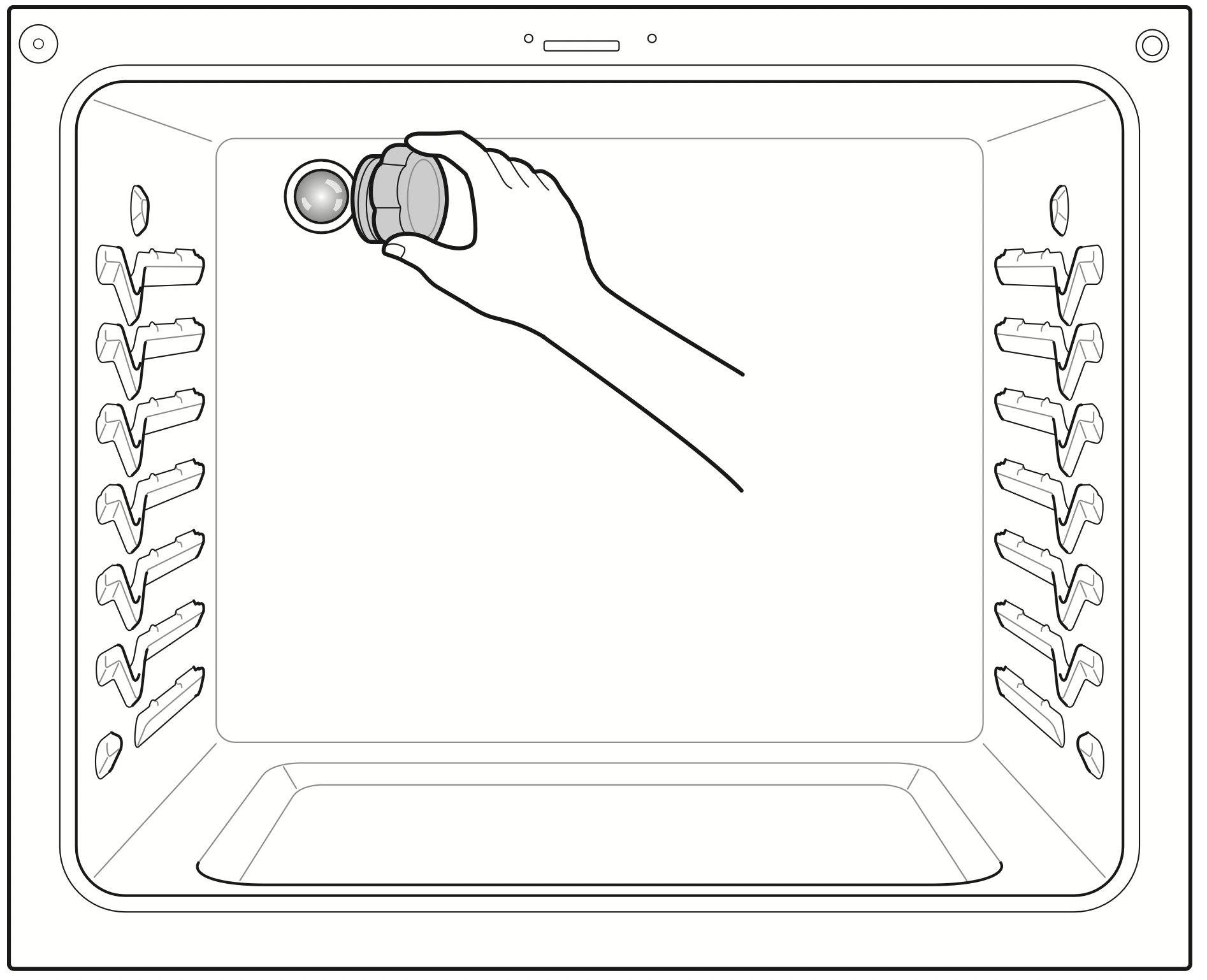
Warning
- Make sure that the oven and bulb are cool.
- Disconnect the electrical power to the range at the main fuse or circuit breaker panel. Failure to do so can result in severe personal injury, death, or electric shock.
Cleaning the Exterior
Painted and Decorative Trim
For general cleaning, use a cloth with hot soapy water. For more difficult soils and built-up grease, apply a liquid detergent directly onto the soil. Leave it on for 30 to 60 minutes. Rinse with a damp cloth and dry. Do not use abrasive cleaners.
Stainless Steel Surfaces
To avoid scratches, do not use steel wool pads.
- Place a small amount of stainless steel appliance cleaner or polish on a damp cloth or paper towel.
- Clean a small area, rubbing with the grain of the stainless steel if applicable.
- Dry and buff with a clean, dry paper towel or soft cloth.
- Repeat as necessary.
Oven Door
- Use soapy water to thoroughly clean the oven door.
Rinse well. Do not immerse the door in water. - You may use a glass cleaner on the outside glass of the oven door. Do not spray water or glass cleaner on the door vents.
- Do not use oven cleaners, cleaning powders, or harsh abrasive cleaning materials on the outside of the oven door.
- Do not clean the oven door gasket. The oven door gasket is made of a woven material that is essential for a good seal. Care should be taken not to rub, damage, or remove this gasket.
CAUTION: Do not use harsh cleaners or harsh abrasive cleaning materials on the outside of the oven door. Doing so can cause damage.

Broiler Pan and Grid

- Do not store a soiled broiler pan or grid anywhere in the range.
- Do not clean the broiler pan or grid in a self-cleaning mode.
- Remove the grid from the pan. Carefully pour out the grease from the pan into a proper container.
- Wash and rinse the broiler pan and grid in hot water with a soap-filled or plastic scouring pad.
- If food has burned on, sprinkle the grid with cleaner while hot and cover with wet paper towels or a dishcloth. Soaking the pan will remove burned-on foods.
- Both the broiler pan and grid may be cleaned with a commercial oven cleaner or in the dishwasher.
Removing and Replacing the Lift-Off Oven Doors and Drawer
CAUTION
- Be careful when removing and lifting the door.
- Do not lift the door by the handle. The door is very heavy.
Removing the Door
- Fully open the door.
- Unlock the hinge locks, rotating them as far toward the open door frame as they will go.
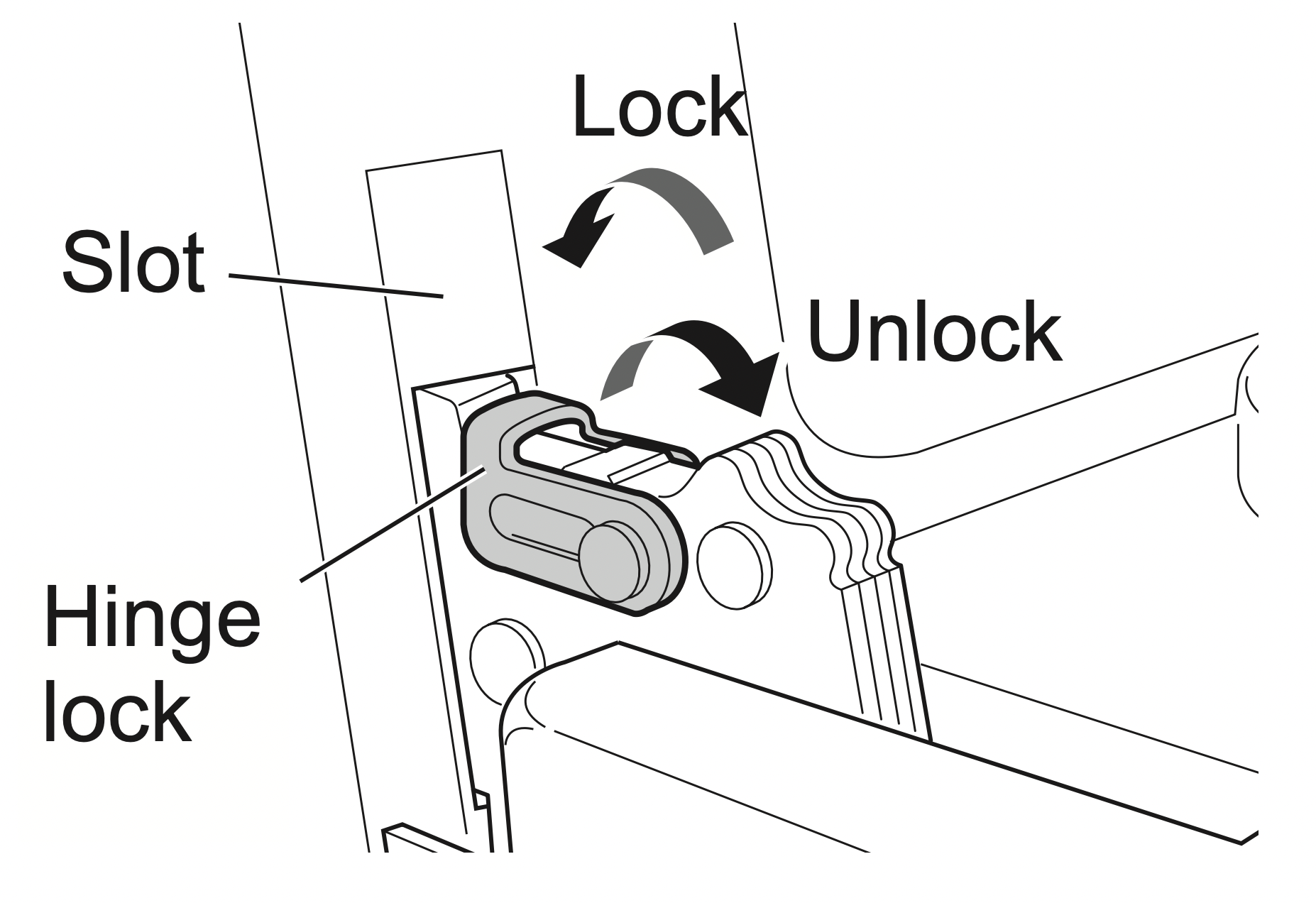
- Firmly grasp both sides of the door at the top.
- Close the door to the removal position (approximately five degrees) which is halfway between the broil stop position and fully closed. If the position is correct, the hinge arms will move freely.
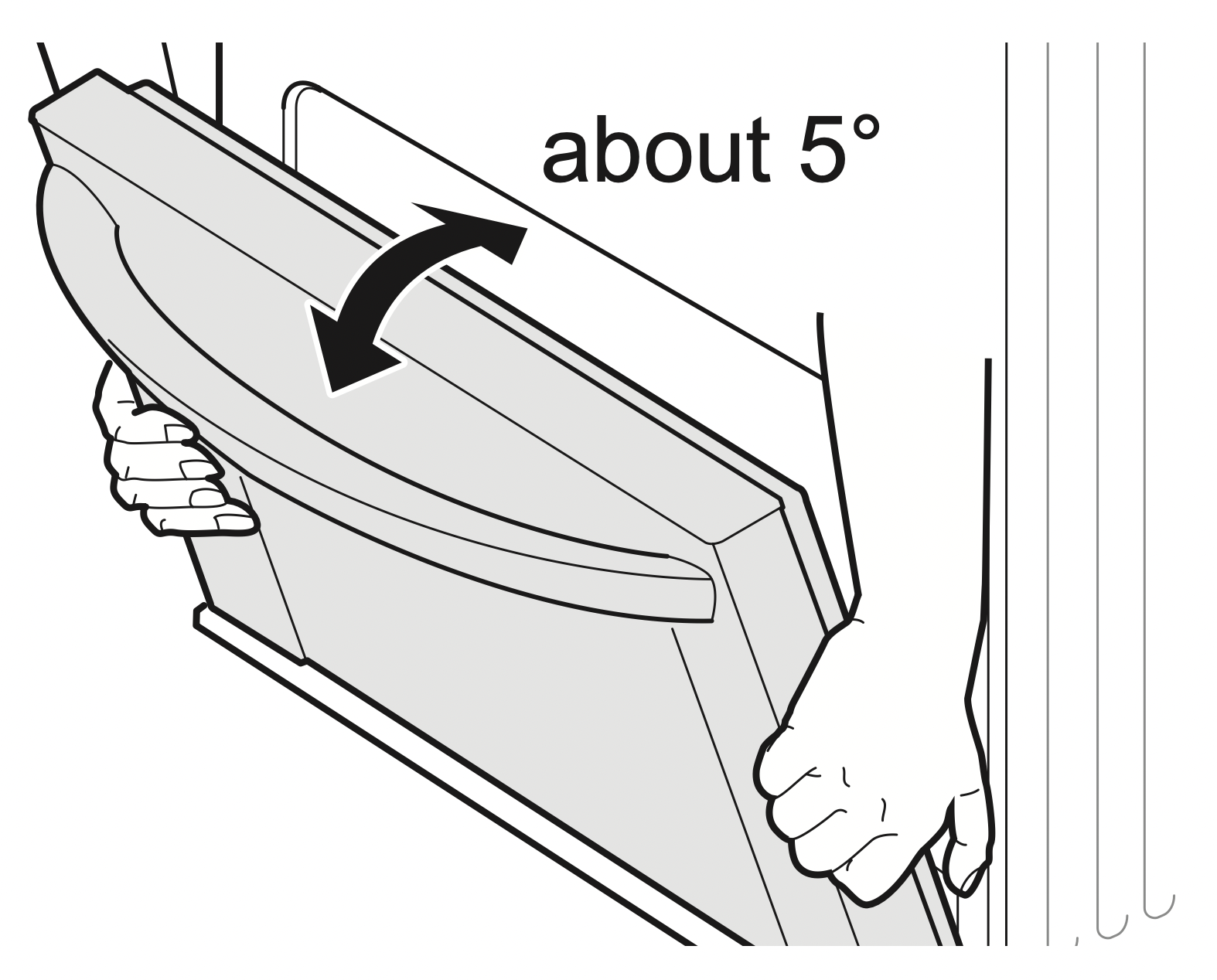
- Lift door up and out until the hinge arms are clear of the slots.
Replacing the Door
- Firmly grasp both sides of the door at the top.
- With the door at the same angle as the removal position, seat the indentation of the hinge arms into the bottom edge of the hinge slots. The notch in the hinge arms must be fully seated into the bottom edge of the slots.

- Open the door fully. If the door will not open fully, the indentation is not seated correctly in the bottom edge of the slots.
- Lock the hinge locks, rotating them back toward the slots in the oven frame until they lock.
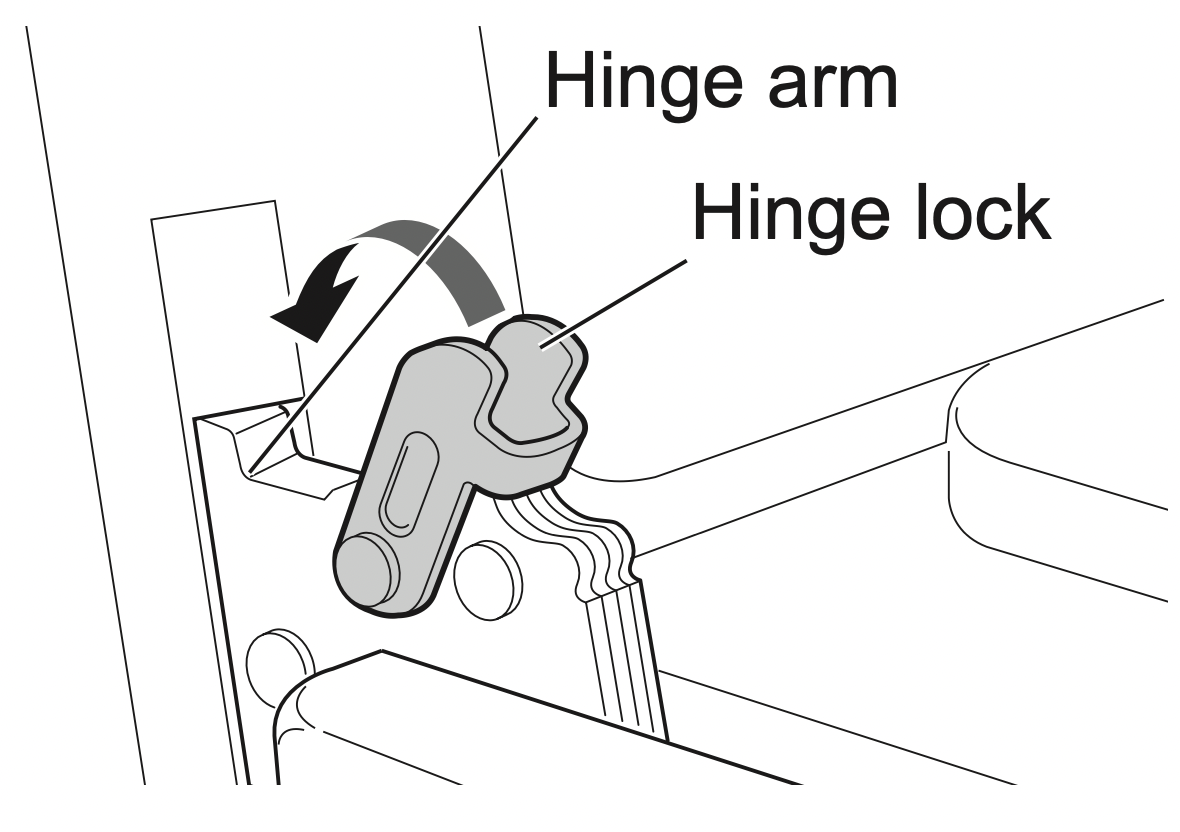
- Close the oven door.
Removing the Drawer
CAUTION: Disconnect the electrical power to the range at the main fuse or circuit breaker panel. Failure to do so can result in severe personal injury, death, or electric shock.
Most cleaning can be done with the drawer in place; however, the drawer may be removed if further cleaning is needed. Use warm water to thoroughly clean.
- Fully open the drawer.
- Locate the glide lever on each side of the drawer. Push down on the left glide lever and pull up on the right glide lever. You may need to pull the levers out slightly to bypass the screws in the glides.

- Pull the drawer away from the range.
Replacing the Drawer
- Pull the bearing glides to the front of the chassis glides.
- Align the glide on each side of the drawer with the glide slots on the range.
- Push the drawer into the range until the levers click (approximately 2 inches).
- Pull the drawer open again to seat the bearing glides into position.
Door Care Instructions
Most oven doors contain glass that can break.
CAUTION:
- Do not close the oven door until all the oven racks are fully in place.
- Do not hit the glass with pots, pans, or any other object.
- Scratching, hitting, jarring, or stressing the glass may weaken its structure causing an increased risk of breakage at a later time.
TROUBLESHOOTING
FAQs
- What types of cookware are recommended for use with the cooktop?
- Look for cookware that is marked "induction ready" or "induction capable" or that is specifically designed for induction cooking.
- The cookware must have a magnetic metallic base.
See the Induction Cookware Types section. - The pans must have a flat bottom and straight sides.
- Only use heavy-gauge pans.
- The pan size must match the amount of food to be prepared and the size of the surface element.
- Use tight fitting lids.
- Only use flat-bottom woks.
- Why do the heating elements appear to be turning and O FF during use of the cooktop or oven?
- Depending on your cooktop element setting or the temperature selected in your oven it is NORMAL for the cooking elements to cycle on and off.
- My new oven doesn’t cook like my old one. Is there something wrong with the temperature settings?
- No, your oven has been factory tested and calibrated. For the first few uses, follow your recipe times and temperatures carefully. If you still think your new oven is too hot or too cold, you can adjust the oven temperature yourself to meet your specific cooking needs. Refer to the Oven Temperature Adjustment section in this manual for easy instructions on how to adjust your thermostat.
- Is it normal to hear a clicking noise coming from the back of my oven when I am using it?
- Your new range is designed to maintain a tighter control over your oven’s temperature. You may hear your oven’s heating elements click on and off more frequently on your new oven. This is NORMAL.
- Why is the colon in the clock flashing?
- This means that the product has just been plugged in, or that it has experienced a power interruption. To clear the flashing colon in the clock, press any key or reset the clock if needed.
- Can I use aluminum foil to catch drippings in my oven cavity?
- Never use aluminum foil to line the bottom or sides of the oven or the warming drawer. The foil will melt and stick to the bottom surface of the oven and will not be removable. Use a sheet pan placed on a lower oven rack to catch drippings instead. (If foil has already melted onto the bottom of the oven, it will not interfere with the oven’s performance.)
- During convection cooking the fan stops when I open the door. Is that normal?
- Yes, this is normal. When the door is opened, the convection fan will stop until the door is closed.
- Can I use aluminum foil to catch drippings in my oven cavity?
- Never use aluminum foil to line the bottom or sides of the oven or the warming drawer. The foil will melt and stick to the bottom surface of the oven and will not be removable. Use a sheet pan placed on a lower oven rack to catch drippings instead. (If foil has already melted onto the bottom of the oven, it will not interfere with the oven's performance.)
- Can I use aluminum foil on the racks?
- Do not cover racks with aluminum foil. Covering entire racks with foil restricts air flow, leading to poor cooking results. Use a sheet pan lined with foil under fruit pies or other acidic or sugary foods to prevent spillovers from damaging the oven finish.
CAUTION: Foil may be used to wrap food in the oven or warming drawer, but do not allow the foil to come into contact with the exposed heating/broiling elements in the oven. The foil could melt or ignite, causing smoke, fire, or injury.
- Do not cover racks with aluminum foil. Covering entire racks with foil restricts air flow, leading to poor cooking results. Use a sheet pan lined with foil under fruit pies or other acidic or sugary foods to prevent spillovers from damaging the oven finish.
- Can I leave my racks in the oven when running a Self Clean cycle?
- No. Although it will not damage the racks, it will discolor them and may make them hard to slide in and out during use. Remove all items from the oven before starting a Self Clean cycle.
- What should I do if my racks are sticky and have become hard to slide in and out?
- Over time, the racks may become hard to slide in and out. Apply a small amount of olive oil to the ends of the racks. This will work as a lubricant for easier gliding.
- What should I do for hard to remove stains on my cooktop?
- The cooktop should be cleaned after every use to prevent permanent staining. When cooking foods with high sugar content, such as tomato sauce, clean the stain off with a scraper while the cooktop is still warm. Use an oven mitt when scraping to prevent burns. Refer to the MAINTENANCE section of this owner's manual for further instruction.
- Why aren't the function buttons working?
- Make sure that the range is not in Lockout mode. The lock
 will show in the display if Lockout is activated. To deactivate Lockout, press Probe (LSE4617 model only), or Clock for three seconds. The unlock melody sounds and Loc appears in the display until the controls are unlocked.
will show in the display if Lockout is activated. To deactivate Lockout, press Probe (LSE4617 model only), or Clock for three seconds. The unlock melody sounds and Loc appears in the display until the controls are unlocked.
- Make sure that the range is not in Lockout mode. The lock
- My range is still dirty after running the EasyClean® cycle. What else should I do?
- The EasyClean® cycle only helps to loosen light soils in your oven range to assist in hand-cleaning of your oven. It does not automatically remove all soils after the cycle. Some scrubbing of your oven range is required after running the EasyClean® cycle.
- I tried scrubbing my oven after running EasyClean®, but some soils still remain. What can I do?
- The EasyClean® feature works best when the soils are fully soaked and submerged in water before running the cycle and during hand-cleaning. If soils are not sufficiently soaked in water, it can negatively affect the cleaning performance. Repeat the EasyClean® process using sufficient water. Sugar-based and certain greasy soils are especially hard to clean. If some stubborn soils remain, use the Self Clean feature to thoroughly clean your oven.
- Soils on my oven walls are not coming off. How can I get my walls clean?
- Soils on the side and rear walls of your oven range may be more difficult to fully soak with water. Try repeating the EasyClean ® process with more than the ¼ cup (2 oz or 60ml) spray recommended.
- Will EasyClean® get all of the soils and stains out completely?
- It depends on the soil type. Sugar-based and certain grease stains are especially hard to clean. Also, if stains are not sufficiently soaked in water, this can negatively affect cleaning performance. If stubborn or built-up stains remain, use the Self Clean feature. Refer to the Self Clean section of your owner' s manual.
- Are there any tricks to getting some of the stubborn soils out?
- Scraping the soils with a plastic scraper before and during hand-cleaning is recommended. Fully saturating soils with water is also recommended. However, certain types of soils are harder to clean than others. For these stubborn soils, the Self Clean cycle is recommended. Consult the Self Clean section of your owner' s manual for details.
- Is it safe for my convection fan, broil burner or heater element to get wet during EasyClean ® ?
- Yes. The convection fan, broiler burner or heater element may get a little wet during cleaning. However, direct spray onto the broil burner and heater elements is not necessary because these are self-cleaning during regular use.
- Do I need to use all 1¼ cup (10 oz or 300ml) of water for EasyClean®?
- Yes. It is highly recommended that 1 cup (8 oz or 240 ml) of water be sprayed or poured on the bottom and an additional ¼ cup (2 oz or 60 ml) of water be sprayed on walls and other soiled areas to fully saturate the soils for better cleaning performance.
- I see smoke coming out of my oven range’s cooktop vents during EasyClean®. Is this normal?
- This is normal. This is not smoke. It is actually water vapor (steam) from the water in the oven cavity. As the oven heats briefly during EasyClean®, the water in the cavity evaporates and escapes through the oven vents.
- How often should I use EasyClean®?
- EasyClean® can be performed as often as you wish. EasyClean® works best when your oven is LIGHTLY soiled from such things as LIGHT grease splatter and small drops of cheese. Please refer to the EasyClean® section in your owner's manual for more information.
- What is required for EasyClean®?
- A spray bottle filled with 1¼ cups (10 oz or 300 ml) of water, a plastic scraper, a non-scratch scrubbing pad and a towel. You should not use abrasive scrubbers such as heavy-duty scouring pads or steel wool.
Except for a towel, all of the materials you need are included in a special cleaning kit with your new range.
- A spray bottle filled with 1¼ cups (10 oz or 300 ml) of water, a plastic scraper, a non-scratch scrubbing pad and a towel. You should not use abrasive scrubbers such as heavy-duty scouring pads or steel wool.
Before Calling for Service
Before you call for service, review this list. It may save you time and expense. The list includes common occurrences that are not the result of defective workmanship or materials in this appliance.
| Symptoms |
Possible Causes / Solutions |
|---|---|
|
Range is not level. |
|
|
Cannot move appliance easily. |
|
|
Oven control beeps and displays any F code error. |
|
|
Surface element control beeps and entire LED bar flashes.
|
|
|
Surface units will not maintain a rolling boil or cooking is not fast enough |
|
|
Surface units do not work properly |
|
|
A reas of discoloration on the cooktop |
|
|
Frequent cycling on and off of surface units |
|
|
Oven will not work |
|
|
Steam is exhausted through the oven vent. |
|
|
Appliance does not operate. |
|
|
Oven light does not work. |
|
|
Oven smokes excessively during broiling. |
|
|
Food does not bake or roast properly |
|
|
Food does not broil properly |
|
|
Oven temperature too hot or too cold |
|
|
Scratches or abrasions on cooktop surface |
|
|
Metal marks |
|
|
Brown streaks or specks |
|
|
A reas of discoloration on cooktop |
|
|
Oven will not Self Clean |
|
|
"Crackling" or "popping" sound |
|
|
Fan noise |
|
|
Convection Fan stops |
|
|
Displayed colon in the clock is flashing |
|
|
Excessive smoking during a Self Clean cycle |
|
|
Oven door does not open after a Self Clean cycle |
|
|
The oven does not clean after a Self Clean cycle |
|
|
CLEAN and door flash in the display |
|
|
LOCKED is on in the display when you want to cook |
|
|
Burning or oily odor emitting from the vent |
|
|
Oven racks are difficult to slide |
|
|
Moisture collects on oven window or steam comes from oven vent |
|
|
Wifi network does not connect properly. |
|
|
Surface elements frequently cycle on and off. |
|
|
Trouble connecting appliance and smartphone to Wi-Fi network |
|


